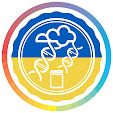小布希主政那八年,是美國科學界最黑暗的時期,不僅經費被變相大幅縮減,還指使幕僚擅自更改科學報告以符合他們無恥的利益,並且以意識形態主導科學研究,阻撓有益人類福祉的幹細胞研究,以及限制綠色能量的發展,罪證真是罄竹難書。
這個影片雖然有點過時了,是共和黨的前副總統候選人潘林幹譙果蠅研究的影片。我原本以為潘林是在幹譙我們這些從事不實用的果蠅的科學家,後來才知道她幹譙的是法國從事果實蠅研究的科學家。基本上,幹譙我們這些做基礎研究的科學家,已經夠愚蠢了,可是她居然還更愚蠢一百倍不止。
在英文Fruit Fly指的可以是Drosophila屬的果蠅,也可以指Tephritidae科的果實蠅,兩者大不同,前者是對農業是無害的,後者則是很恐怖的害蟲。單單在加州,每年因地中海果實蠅危害造成的損失就超過12億美元,世界各國都把果實蠅害蟲的檢疫列為重點,嚴格禁止闖關輸入。所以,研究果蠅,可能對人類福祉毫無作為,可是研究果實蠅,卻是對農業和經濟有很大的幫助的。小賤潘連這點都搞不清楚,如果小賤肯當選了,美國還有未來嗎?
還好,美國終於有一位有為的總統上台了。在他的就職演說中,歐巴馬就明確地指出,他要把科學研究當為施政優先。歐巴馬上任百日,證實他大多數情況下,並未食言。他很快地解除了小布希政府對聯邦經費贊助幹細胞研究的限制,也承諾把GDP的3%應用在科學研發,並且把科研經費在十年內成倍增長,也把刺激經濟的聯邦預算花好一部分在替代能源的研究。在4/27的美國國家科學院年度院會暨新科院士當選日,他明確地表示對科學界的支持,希望他能夠為科學界再度帶來曙光!
相關新聞報導:歐巴馬:GDP3%以上 用於科學研發
【世界日報╱編譯中心綜合華盛頓27日電】
歐巴馬總統27日誓言對美國的科學創新做歷來規模最大的投資,計劃把國內生產總值(GDP)的3%以上(超過4200億元),用於科學研發,使美國重登科技巔峰。他說,美國已落後其他國家,必須迎頭趕上。
歐巴馬在國家科學院(National Academy of Sciences)年會發表演說,揭示他雄心勃勃的科技計畫。他說,他提出的重大投資計畫將導致科技突破,讓太陽能電池像油漆一樣便宜,建造出能夠自行生產能源的「綠色大樓」。
他說:「本人相信,美國人的本色不是跟在別人後面,而是領導。現在正是我們再度領導的時刻。本人在此立下目標:我們將把GDP的3%以上,用於科學研發。」
他說:「我們不僅要達到(美、蘇)太空競賽高潮時期獲致的科技水準,更要超越。半世紀前追求新發現的努力,助長美國的繁榮與成功。本人今天所做的承諾,將推動今後50年的成功。這項工作將從我們對基礎科學和應用研究的歷史性承諾開始。」
歐巴馬舉出他希望達成的許多願望:教學軟體像私人教師授課一樣有效;先進的義肢讓患者能夠彈鋼琴;擴大人類的知識領域,讓人類對自己和周圍的世界有更透徹的了解。他強調:「我們一定可以做到(We can do this)。」這句話引起全場的掌聲。
他說,聯邦政府將把科學有關機構的預算增加一倍,包括國家科學基金會(National Science Foundation)、能源部科學署、國家標準科技學院(National Institute of Standards and Technology,NIST)。
儘管經濟前景不明,又遭逢豬流感帶來上任以來第一個全球重大公共衛生危機,一心要扭轉布希總統意識形態主導政策的歐巴馬,大聲疾呼提升科技。
他說:「在此艱困時刻,有些人說,我們負擔不起科學投資,目前是需要決定一切的時刻,支持科學研發,有點奢侈。本人絕不同意這種看法。國的繁榮、安全、保健、環保及生活品質,從未像現在這麼重要。」
【2009/04/28 世界日報】
歐巴馬演說部分原文重點節錄:"I am here today to set this goal: we will devote more than three percent of our GDP to research and development. We will not just meet, but we will exceed the level achieved at the height of the Space Race, through policies that invest in basic and applied research, create new incentives for private innovation, promote breakthroughs in energy and medicine, and improve education in math and science."
"This work begins with an historic commitment to basic science and applied research, from the labs of renowned universities to the proving grounds of innovative companies."
"Second, in no area will innovation be more important than in the development of new technologies to produce, use, and save energy."
"Third, in order to lead in the global economy and ensure that our businesses can grow and innovate, and our families can thrive we must address the shortcomings of our health care system."
"The Recovery Act will support the long overdue step of computerizing America's medical records, to reduce the duplication, waste, and errors that cost billions of dollars and thousands of lives. But it's important to note: these records also hold the potential of offering patients the chance to be more active participants in prevention and treatment. We must maintain patient control over these records and respect their privacy. At the same time, however, we have the opportunity to offer billions and billions of anonymous data points to medical researchers who may find in this information evidence that can help us better understand disease."
"Fourth, we are restoring science to its rightful place."
"In environmental science, it will require strengthening our weather forecasting, our earth observation from space, the management of our nation's land, water and forests, and the stewardship of our coastal zones and ocean fisheries."
"Fifth, since we know that the progress and prosperity of future generations will depend on what we do now to educate the next generation, today I am announcing a renewed commitment to education in mathematics and science."
"Think about new and creative ways to engage young people in science and engineering, like science festivals, robotics competitions, and fairs that encourage young people to create, build, and invent to be makers of things, not just consumers of things."
"As President Kennedy said when he addressed the National Academy of Sciences more than 45 years ago: 'The challenge, in short, may be our salvation.' Thank you all for your past, present, and future discoveries."
歐巴馬在美國國家科學院演說全文:Well, thank you so much for the wonderful welcome. To President Cicerone, thank you very much for your leadership and for hosting us today. To John Holdren, thanks, John, for the outstanding work that you are doing.
I was just informed backstage that Ralph and John both are 1965 graduates of MIT -- same class. And so I'm not sure this is the perfectly prescribed scientific method, but they're sort of a control group -- (laughter) -- who ages faster: The President's Science Advisor or the President of the Academy? (Laughter.) And we'll check in in a couple of years. But it is wonderful to see them.
To all of you, to my Cabinet Secretaries and team who are here, thank you. It is a great privilege to address the distinguished members of the National Academy of Sciences, as well as the leaders of the National Academy of Engineering and the Institute of Medicine who've gathered here this morning.
And I'd like to begin today with a story of a previous visitor who also addressed this august body. In April of 1921, Albert Einstein visited the United States for the first time. And his international credibility was growing as scientists around the world began to understand and accept the vast implications of his theories of special and general relativity. And he attended this annual meeting, and after sitting through a series of long speeches by others, he reportedly said, "I have just got a new theory of eternity." (Laughter.) So I will do my best to heed this cautionary tale. (Laughter.)
The very founding of this institution stands as a testament to the restless curiosity, the boundless hope so essential not just to the scientific enterprise, but to this experiment we call America.
A few months after a devastating defeat at Fredericksburg, before Gettysburg would be won, before Richmond would fall, before the fate of the Union would be at all certain, President Abraham Lincoln signed into law an act creating the National Academy of Sciences -- in the midst of civil war.
Lincoln refused to accept that our nation's sole purpose was mere survival. He created this academy, founded the land grant colleges, and began the work of the transcontinental railroad, believing that we must add -- and I quote -- "the fuel of interest to the fire of genius in the discovery... of new and useful things."
This is America's story. Even in the hardest times, against the toughest odds, we've never given in to pessimism; we've never surrendered our fates to chance; we have endured; we have worked hard; we sought out new frontiers.
Today, of course, we face more complex challenges than we have ever faced before: a medical system that holds the promise of unlocking new cures and treatments -- attached to a health care system that holds the potential for bankruptcy to families and businesses; a system of energy that powers our economy, but simultaneously endangers our planet; threats to our security that seek to exploit the very interconnectedness and openness so essential to our prosperity; and challenges in a global marketplace which links the derivative trader on Wall Street to the homeowner on Main Street, the office worker in America to the factory worker in China -- a marketplace in which we all share in opportunity, but also in crisis.
At such a difficult moment, there are those who say we cannot afford to invest in science, that support for research is somehow a luxury at moments defined by necessities. I fundamentally disagree. Science is more essential for our prosperity, our security, our health, our environment, and our quality of life than it has ever been before. (Applause.)
And if there was ever a day that reminded us of our shared stake in science and research, it's today. We are closely monitoring the emerging cases of swine flu in the United States. And this is obviously a cause for concern and requires a heightened state of alert. But it's not a cause for alarm. The Department of Health and Human Services has declared a public health emergency as a precautionary tool to ensure that we have the resources we need at our disposal to respond quickly and effectively. And I'm getting regular updates on the situation from the responsible agencies. And the Department of Health and Human Services as well as the Centers for Disease Control will be offering regular updates to the American people. And Secretary Napolitano will be offering regular updates to the American people, as well, so that they know what steps are being taken and what steps they may need to take.
But one thing is clear -- our capacity to deal with a public health challenge of this sort rests heavily on the work of our scientific and medical community. And this is one more example of why we can't allow our nation to fall behind.
Unfortunately, that's exactly what's happened.
Federal funding in the physical sciences as a portion of our gross domestic product has fallen by nearly half over the past quarter century. Time and again we've allowed the research and experimentation tax credit, which helps businesses grow and innovate, to lapse.
Our schools continue to trail other developed countries and, in some cases, developing countries. Our students are outperformed in math and science by their peers in Singapore, Japan, England, the Netherlands, Hong Kong, and Korea, among others. Another assessment shows American 15-year-olds ranked 25th in math and 21st in science when compared to nations around the world. And we have watched as scientific integrity has been undermined and scientific research politicized in an effort to advance predetermined ideological agendas.
We know that our country is better than this. A half century ago, this nation made a commitment to lead the world in scientific and technological innovation; to invest in education, in research, in engineering; to set a goal of reaching space and engaging every citizen in that historic mission. That was the high water mark of America's investment in research and development. And since then our investments have steadily declined as a share of our national income. As a result, other countries are now beginning to pull ahead in the pursuit of this generation's great discoveries.
I believe it is not in our character, the American character, to follow. It's our character to lead. And it is time for us to lead once again. So I'm here today to set this goal: We will devote more than 3 percent of our GDP to research and development. We will not just meet, but we will exceed the level achieved at the height of the space race, through policies that invest in basic and applied research, create new incentives for private innovation, promote breakthroughs in energy and medicine, and improve education in math and science. (Applause.)
This represents the largest commitment to scientific research and innovation in American history.
Just think what this will allow us to accomplish: solar cells as cheap as paint; green buildings that produce all the energy they consume; learning software as effective as a personal tutor; prosthetics so advanced that you could play the piano again; an expansion of the frontiers of human knowledge about ourselves and world the around us. We can do this.
The pursuit of discovery half a century ago fueled our prosperity and our success as a nation in the half century that followed. The commitment I am making today will fuel our success for another 50 years. That's how we will ensure that our children and their children will look back on this generation's work as that which defined the progress and delivered the prosperity of the 21st century.
This work begins with a historic commitment to basic science and applied research, from the labs of renowned universities to the proving grounds of innovative companies.
Through the American Recovery and Reinvestment Act, and with the support of Congress, my administration is already providing the largest single boost to investment in basic research in American history. That's already happened.
This is important right now, as public and private colleges and universities across the country reckon with shrinking endowments and tightening budgets. But this is also incredibly important for our future. As Vannevar Bush, who served as scientific advisor to President Franklin Roosevelt, famously said: "Basic scientific research is scientific capital."
The fact is an investigation into a particular physical, chemical, or biological process might not pay off for a year, or a decade, or at all. And when it does, the rewards are often broadly shared, enjoyed by those who bore its costs but also by those who did not.
And that's why the private sector generally under-invests in basic science, and why the public sector must invest in this kind of research -- because while the risks may be large, so are the rewards for our economy and our society.
No one can predict what new applications will be born of basic research: new treatments in our hospitals, or new sources of efficient energy; new building materials; new kinds of crops more resistant to heat and to drought.
It was basic research in the photoelectric field -- in the photoelectric effect that would one day lead to solar panels. It was basic research in physics that would eventually produce the CAT scan. The calculations of today's GPS satellites are based on the equations that Einstein put to paper more than a century ago.
In addition to the investments in the Recovery Act, the budget I've proposed -- and versions have now passed both the House and the Senate -- builds on the historic investments in research contained in the recovery plan.
So we double the budget of key agencies, including the National Science Foundation, a primary source of funding for academic research; and the National Institute of Standards and Technology, which supports a wide range of pursuits from improving health information technology to measuring carbon pollution, from -- from testing "smart grid" designs to developing advanced manufacturing processes.
And my budget doubles funding for the Department of Energy's Office of Science, which builds and operates accelerators, colliders, supercomputers, high-energy light sources, and facilities for making nano-materials -- because we know that a nation's potential for scientific discovery is defined by the tools that it makes available to its researchers.
But the renewed commitment of our nation will not be driven by government investment alone. It's a commitment that extends from the laboratory to the marketplace. And that's why my budget makes the research and experimentation tax credit permanent. This is a tax credit that returns two dollars to the economy for every dollar we spend, by helping companies afford the often high costs of developing new ideas, new technologies, and new products. Yet at times we've allowed it to lapse or only renewed it year to year. I've heard this time and again from entrepreneurs across this country: By making this credit permanent we make it possible for businesses to plan the kinds of projects that create jobs and economic growth.
Second, in no area will innovation be more important than in the development of new technologies to produce, use, and save energy -- which is why my administration has made an unprecedented commitment to developing a 21st century clean energy economy, and why we put a scientist in charge of the Department of Energy. (Applause.)
Our future on this planet depends on our willingness to address the challenge posed by carbon pollution. And our future as a nation depends upon our willingness to embrace this challenge as an opportunity to lead the world in pursuit of new discovery.
When the Soviet Union launched Sputnik a little more than a half century ago, Americans were stunned. The Russians had beaten us to space. And we had to make a choice: We could accept defeat or we could accept the challenge. And as always, we chose to accept the challenge.
President Eisenhower signed legislation to create NASA and to invest in science and math education, from grade school to graduate school. And just a few years later, a month after his address to the 1961 Annual Meeting of the National Academy of Sciences, President Kennedy boldly declared before a joint session of Congress that the United States would send a man to the moon and return him safely to the Earth.
The scientific community rallied behind this goal and set about achieving it. And it would not only lead to those first steps on the moon; it would lead to giant leaps in our understanding here at home. That Apollo program produced technologies that have improved kidney dialysis and water purification systems; sensors to test for hazardous gasses; energy-saving building materials; fire-resistant fabrics used by firefighters and soldiers. More broadly, the enormous investment in that era –- in science and technology, in education and research funding –- produced a great outpouring of curiosity and creativity, the benefits of which have been incalculable. There are those of you in this audience who became scientists because of that commitment. We have to replicate that.
There will be no single Sputnik moment for this generation's challenges to break our dependence on fossil fuels. In many ways, this makes the challenge even tougher to solve –- and makes it all the more important to keep our eyes fixed on the work ahead.
But energy is our great project, this generation's great project. And that's why I've set a goal for our nation that we will reduce our carbon pollution by more than 80 percent by 2050. And that is why -- (applause) -- and that is why I'm pursuing, in concert with Congress, the policies that will help meet us -- help us meet this goal.
My recovery plan provides the incentives to double our nation's capacity to generate renewable energy over the next few years -- extending the production tax credit, providing loan guarantees and offering grants to spur investment. Just take one example: Federally funded research and development has dropped the cost of solar panels by tenfold over the last three decades. Our renewed efforts will ensure that solar and other clean energy technologies will be competitive.
My budget includes $150 billion over 10 years to invest in sources of renewable energy as well as energy efficiency. It supports efforts at NASA, recommended as a priority by the National Research Council, to develop new space-based capabilities to help us better understand our changing climate.
And today, I'm also announcing that for the first time, we are funding an initiative -- recommended by this organization -- called the Advanced Research Projects Agency for Energy, or ARPA-E. (Applause.)
This is based, not surprisingly, on DARPA, the Defense Advanced Research Projects Agency, which was created during the Eisenhower administration in response to Sputnik. It has been charged throughout its history with conducting high-risk, high-reward research. And the precursor to the Internet, known as ARPANET, stealth technology, the Global Positioning System all owe a debt to the work of DARPA.
So ARPA-E seeks to do the same kind of high-risk, high-reward research. My administration will pursue, as well, comprehensive legislation to place a market-based cap on carbon emissions. We will make renewable energy the profitable kind of energy. We will put in place the resources so that scientists can focus on this critical area. And I am confident that we will find a wellspring of creativity just waiting to be tapped by researchers in this room and entrepreneurs across our country. We can solve this problem. (Applause.)
Now, the nation that leads the world in 21st century clean energy will be the nation that leads in the 21st century global economy. I believe America can and must be that nation. But in order to lead in the global economy and to ensure that our businesses can grow and innovate, and our families can thrive, we're also going to have to address the shortcomings of our health care system.
The Recovery Act will support the long overdue step of computerizing America's medical records, to reduce the duplication, waste and errors that cost billions of dollars and thousands of lives.
But it's important to note, these records also hold the potential of offering patients the chance to be more active participants in the prevention and treatment of their diseases. We must maintain patient control over these records and respect their privacy. At the same time, we have the opportunity to offer billions and billions of anonymous data points to medical researchers who may find in this information evidence that can help us better understand disease.
History also teaches us the greatest advances in medicine have come from scientific breakthroughs, whether the discovery of antibiotics, or improved public health practices, vaccines for smallpox and polio and many other infectious diseases, antiretroviral drugs that can return AIDS patients to productive lives, pills that can control certain types of blood cancers, so many others.
Because of recent progress –- not just in biology, genetics and medicine, but also in physics, chemistry, computer science, and engineering –- we have the potential to make enormous progress against diseases in the coming decades. And that's why my administration is committed to increasing funding for the National Institutes of Health, including $6 billion to support cancer research -- part of a sustained, multi-year plan to double cancer research in our country. (Applause.)
Next, we are restoring science to its rightful place. On March 9th, I signed an executive memorandum with a clear message: Under my administration, the days of science taking a back seat to ideology are over. (Applause.) Our progress as a nation –- and our values as a nation –- are rooted in free and open inquiry. To undermine scientific integrity is to undermine our democracy. It is contrary to our way of life. (Applause.)
That's why I've charged John Holdren and the White House Office of Science and Technology Policy with leading a new effort to ensure that federal policies are based on the best and most unbiased scientific information. I want to be sure that facts are driving scientific decisions -- and not the other way around. (Laughter.)
As part of this effort, we've already launched a web site that allows individuals to not only make recommendations to achieve this goal, but to collaborate on those recommendations. It's a small step, but one that's creating a more transparent, participatory and democratic government.
We also need to engage the scientific community directly in the work of public policy. And that's why, today, I am announcing the appointment -- we are filling out the President's Council of Advisors on Science and Technology, known as PCAST, and I intend to work with them closely. Our co-chairs have already been introduced -- Dr. Varmus and Dr. Lander along with John. And this council represents leaders from many scientific disciplines who will bring a diversity of experiences and views. And I will charge PCAST with advising me about national strategies to nurture and sustain a culture of scientific innovation.
In addition to John -- sorry, the -- I just noticed that I jumped the gun here -- go ahead and move it up. (Laughter.) I'd already -- I'd already introduced all you guys.
In biomedicine, just to give you an example of what PCAST can do, we can harness the historic convergence between life sciences and physical sciences that's underway today; undertaking public projects -- in the spirit of the Human Genome Project -- to create data and capabilities that fuel discoveries in tens of thousands of laboratories; and identifying and overcoming scientific and bureaucratic barriers to rapidly translating scientific breakthroughs into diagnostics and therapeutics that serve patients.
In environmental science, it will require strengthening our weather forecasting, our Earth observation from space, the management of our nation's land, water and forests, and the stewardship of our coastal zones and ocean fisheries.
We also need to work with our friends around the world. Science, technology and innovation proceed more rapidly and more cost-effectively when insights, costs and risks are shared; and so many of the challenges that science and technology will help us meet are global in character. This is true of our dependence on oil, the consequences of climate change, the threat of epidemic disease, and the spread of nuclear weapons.
And that's why my administration is ramping up participation in -- and our commitment to -- international science and technology cooperation across the many areas where it is clearly in our interest to do so. In fact, this week, my administration is gathering the leaders of the world's major economies to begin the work of addressing our common energy challenges together.
Fifth, since we know that the progress and prosperity of future generations will depend on what we do now to educate the next generation, today I'm announcing a renewed commitment to education in mathematics and science. (Applause.) This is something I care deeply about. Through this commitment, American students will move from the middle of the top -- from the middle to the top of the pack in science and math over the next decade -- for we know that the nation that out-educates us today will out-compete us tomorrow. And I don't intend to have us out-educated.
We can't start soon enough. We know that the quality of math and science teachers is the most influential single factor in determining whether a student will succeed or fail in these subjects. Yet in high school more than 20 percent of students in math and more than 60 percent of students in chemistry and physics are taught by teachers without expertise in these fields. And this problem is only going to get worse. There is a projected shortfall of more than 280,000 math and science teachers across the country by 2015.
And that's why I'm announcing today that states making strong commitments and progress in math and science education will be eligible to compete later this fall for additional funds under the Secretary of Education's $5 billion Race to the Top program.
And I'm challenging states to dramatically improve achievement in math and science by raising standards, modernizing science labs, upgrading curriculum, and forging partnerships to improve the use of science and technology in our classrooms. (Applause.) I'm challenging states, as well, to enhance teacher preparation and training, and to attract new and qualified math and science teachers to better engage students and reinvigorate those subjects in our schools.
And in this endeavor, we will work to support inventive approaches. Let's create systems that retain and reward effective teachers, and let's create new pathways for experienced professionals to go into the classroom. There are, right now, chemists who could teach chemistry, physicists who could teach physics, statisticians who could teach mathematics. But we need to create a way to bring the expertise and the enthusiasm of these folks –- folks like you –- into the classroom.
There are states, for example, doing innovative work. I'm pleased to announce that Governor Ed Rendell of Pennsylvania will lead an effort with the National Governors Association to increase the number of states that are making science, technology, engineering and mathematics education a top priority. Six states are currently participating in the initiative, including Pennsylvania, which has launched an effective program to ensure that the state has the skilled workforce in place to draw the jobs of the 21st century. And I want every state, all 50 states, to participate.
But as you know, our work does not end with a high school diploma. For decades, we led the world in educational attainment, and as a consequence we led the world in economic growth. The G.I. Bill, for example, helps send a generation to college. But in this new economy, we've come to trail other nations in graduation rates, in educational achievement, and in the production of scientists and engineers.
That's why my administration has set a goal that will greatly enhance our ability to compete for the high-wage, high-tech jobs of the future –- and to foster the next generation of scientists and engineers. In the next decade –- by 2020 –- America will once again have the highest proportion of college graduates in the world. That is a goal that we are going to set. And we've provided tax credits and grants to make a college education more affordable.
My budget also triples the number of National Science Foundation graduate research fellowships. (Applause.) This program was created as part of the space race five decades ago. In the decades since, it's remained largely the same size –- even as the numbers of students who seek these fellowships has skyrocketed. We ought to be supporting these young people who are pursuing scientific careers, not putting obstacles in their path.
So this is how we will lead the world in new discoveries in this new century. But I think all of you understand it will take far more than the work of government. It will take all of us. It will take all of you. And so today I want to challenge you to use your love and knowledge of science to spark the same sense of wonder and excitement in a new generation.
America's young people will rise to the challenge if given the opportunity –- if called upon to join a cause larger than themselves. We've got evidence. You know, the average age in NASA's mission control during the Apollo 17 mission was just 26. I know that young people today are just as ready to tackle the grand challenges of this century.
So I want to persuade you to spend time in the classroom, talking and showing young people what it is that your work can mean, and what it means to you. I want to encourage you to participate in programs to allow students to get a degree in science fields and a teaching certificate at the same time. I want us all to think about new and creative ways to engage young people in science and engineering, whether it's science festivals, robotics competitions, fairs that encourage young people to create and build and invent -- to be makers of things, not just consumers of things.
I want you to know that I'm going to be working alongside you. I'm going to participate in a public awareness and outreach campaign to encourage students to consider careers in science and mathematics and engineering -- because our future depends on it.
And the Department of Energy and the National Science Foundation will be launching a joint initiative to inspire tens of thousands of American students to pursue these very same careers, particularly in clean energy.
It will support an educational campaign to capture the imagination of young people who can help us meet the energy challenge, and will create research opportunities for undergraduates and educational opportunities for women and minorities who too often have been underrepresented in scientific and technological fields, but are no less capable of inventing the solutions that will help us grow our economy and save our planet. (Applause.)
And it will support fellowships and interdisciplinary graduate programs and partnerships between academic institutions and innovative companies to prepare a generation of Americans to meet this generational challenge.
For we must always remember that somewhere in America there's an entrepreneur seeking a loan to start a business that could transform an industry -- but she hasn't secured it yet. There's a researcher with an idea for an experiment that might offer a new cancer treatment -– but he hasn't found the funding yet. There's a child with an inquisitive mind staring up at the night sky. And maybe she has the potential to change our world –- but she doesn't know it yet.
As you know, scientific discovery takes far more than the occasional flash of brilliance –- as important as that can be. Usually, it takes time and hard work and patience; it takes training; it requires the support of a nation. But it holds a promise like no other area of human endeavor.
In 1968, a year defined by loss and conflict and tumult, Apollo 8 carried into space the first human beings ever to slip beyond Earth's gravity, and the ship would circle the moon 10 times before returning home. But on its fourth orbit, the capsule rotated and for the first time Earth became visible through the windows.
Bill Anders, one of the astronauts aboard Apollo 8, scrambled for a camera, and he took a photo that showed the Earth coming up over the moon's horizon. It was the first ever taken from so distant a vantage point, and it soon became known as "Earthrise."
Anders would say that the moment forever changed him, to see our world -- this pale blue sphere -- without borders, without divisions, at once so tranquil and beautiful and alone.
"We came all this way to explore the moon," he said, "and the most important thing is that we discovered the Earth."
Yes, scientific innovation offers us a chance to achieve prosperity. It has offered us benefits that have improved our health and our lives -- improvements we take too easily for granted. But it gives us something more. At root, science forces us to reckon with the truth as best as we can ascertain it.
And some truths fill us with awe. Others force us to question long-held views. Science can't answer every question, and indeed, it seems at times the more we plumb the mysteries of the physical world, the more humble we must be. Science cannot supplant our ethics or our values, our principles or our faith. But science can inform those things and help put those values -- these moral sentiments, that faith -- can put those things to work -- to feed a child, or to heal the sick, to be good stewards of this Earth.
We are reminded that with each new discovery and the new power it brings comes new responsibility; that the fragility, the sheer specialness of life requires us to move past our differences and to address our common problems, to endure and continue humanity's strivings for a better world.
As President Kennedy said when he addressed the National Academy of Sciences more than 45 years ago: "The challenge, in short, may be our salvation."
Thank you all for all your past, present, and future discoveries. (Applause.) May God bless you. God bless the United States of America. (Applause.)
相關網站:
歐巴馬就職百日
President Obama Addresses NAS Annual Meeting
延伸閱讀:
The Sky of Gene - 【分享】歐巴馬總統就職典禮演說(Barack Obama Inauguration Speech)
The Sky of Gene - U2 in Obama Concert
The Sky of Gene - 【分享】歐巴馬勝選感言文言版
The Sky of Gene - 【分享】歐巴馬演說(Barack Obama Speeches)
The Sky of Gene - 美國的「朝倉啟太」,台灣的呢?
2009年4月30日 星期四
【分享】歐巴馬美國國家科學院演說
2009年4月28日 星期二
【分享】Google Maps豬流感(H1N1新型流感,H1N1 Swine Flu)傳染地圖
豬流感(H1N1新型流感,H1N1 Swine Flu)在墨西哥開始流行,迄今已有超過三千人感染,超過149人死亡;在美國各地也相繼傳出病例,迄今有超過40人可能感染。基本上,豬流感已進入人傳人的階段,在未來半年內,豬流感病毒H1N1可能會在五大洲傳開流行起來。不過,這個時代科技真是進步,有網友很快地在Google Maps建立豬流感的傳染地圖,相信對大眾瞭解疫情很有幫助吧。
View H1N1 Swine Flu in a larger map
圖示說明:粉紅色圖示是疑似病例。
紫色圖示是已證實或可能是的病例。
沒有點的圖示是已證實,已死亡的病例。
黃色圖示是未感染或已排除的病例。
以下是香港衛生署衛生防護中心提供的人類豬流感 相關資訊(來源):病原體
豬型流感是一種由甲型流感引起的豬隻呼吸道疾病。豬型流感爆發不時會在豬隻間發生。在豬隻身上培養出的流感亞型主要有四種:分別為 H1N1、 H1N2、H3N2 及 H3N1。近期在豬隻發現的流感病毒則多為 H1N1 型。
背景
典型的豬型流感 (甲型流感H1N1 型) 自1930年已經被首先發現,此後並一直在豬隻之間流行。豬隻的甲型流感H1N1型跟人類的甲型流感H1N1型在抗原上是非常不同的,因此在一般情況下豬 型流感是不會感染人類。縱然如此,零星的人類豬型流感個案仍會不時發生。較常見的人類豬型流感是人類直接接觸豬隻(如養豬業從業員)。在人類之間傳播的豬型流感亦可發生。
病徵
人類豬型流感的病徵一般跟人類感染季節性流感相近,包括發燒、疲憊、食慾不振和咳嗽。部分豬型流感患者亦可能出現流鼻水、喉嚨痛、作嘔、嘔吐及腹瀉等徵狀。
傳播途徑
豬型流感可由豬隻直接傳染給人類及由人類傳染給豬隻。在人類之間的傳播亦可發生。傳染途徑相信與季節性流感相同,主要是通過咳嗽或打噴嚏。人類亦可經接觸帶有流感病毒的物件後,接觸口或鼻而受感染。
豬型流感並非由食物傳播。進食經正確處理及煮熟的豬肉及豬肉食品是安全的。烹調豬肉至內部沩度達攝氏71.1度(華氏160度),能有如殺掉其他細菌及病毒般殺死豬型流感病毒。
治理方法
患者應有充足休息和多飲水。支援性治療可紓緩徵狀。雖然抗病毒劑能減輕病情,但必須在發病初期,經由醫生處方才可服用。因此,當出現流感病徵時應及早求醫,切勿自行服藥。除非患者已出現細菌性感染併發症,否則無需服用抗生素。
預防方法
由於H1N1豬型流感病毒跟人類H1N1病毒的抗原非常不同,所以季節性流感的疫苗未能為人類對H1N1豬型流感病毒提供保護。市民應採取以下預防措施﹕
• 保持雙手清潔,並用正確方法洗手。如雙手沒有明顯污垢時,可用酒精搓手液消毒雙手。
• 避免接觸眼、鼻及口。
• 雙手如被呼吸道分泌物污染,例如打噴嚏或咳嗽後,應立即用炉液洗手。
• 打噴嚏或咳嗽時應遮掩口鼻。
• 不要隨地吐痰,應將口鼻分泌物用紙巾包好,棄置於有蓋垃圾箱內。
• 有呼吸道感染徵狀或發燒時,應戴上口罩,並及早求醫。
• 若出現流感徵狀,切勿上班或上學。
另外,前往受影響地方的旅客,應採取防範措施,包括:
• 避免接觸病人。
• 應帶備外科口罩,以便有需要時使用。
• 如外遊途中或返港後出現發燒或類似流感的徵狀,必須立即就醫,並告知醫生有關外遊記錄。
相關網站:
行政院衛生署疾病管制局:認識豬流感
Google News豬流感最新新聞
CDC - Influenza (Flu) | Swine Influenza (Flu)
2009年4月22日 星期三
2009世界地球日(Earth Day)
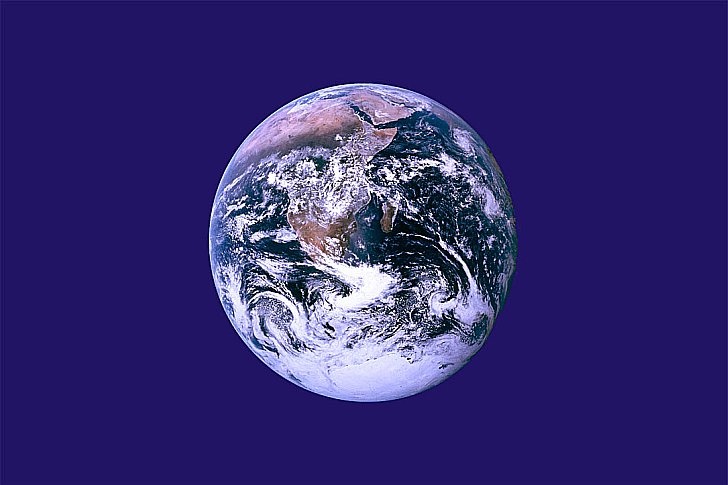
明天4月22日是世界地球日,讓我們一起來好好用心地關心一下地球吧!
世界地球日的基本介紹(來源):世界地球日即每年的4月22日,是一項世界性的環境保護運動。最早的地球日活動是1970年代于美國校園興起的環保運動,1990年代這項活動從美國走向世界,成為全世界環保主義者的節日和環境保護宣傳日,在這天不同國籍的人們以各自不同的方式宣傳和實踐環境保護的觀念。
最初的地球日選擇在春分節氣,這一天在全世界的任何一個角落晝夜時長均相等,陽光可以同時照耀在南極點和北極點上,這代表了世界的平等,同時也象徵著人類要拋開彼此間的爭議和不同,和諧共存。傳統上在很多國家都有慶祝春分節氣的傳統。早期聯合國也在每年的春分舉行世界地球日的活動。
1969年美國民主黨參議員Gaylord Nelson在美國各大學舉行演講會,籌劃在次年的4月22日組織以反對越戰為主題的校園運動,但是在1969年西雅圖召開的籌備會議上,活動的組織者之一,哈佛大學法學院學生Denis Hayes提出將運動定位在於全美國的,以環境保護為主題的草根運動。1970年4月22日在美國各地總共有超過2000萬人參與了環境保護運動,這次運動的成功使得在每年4月22日組織環保活動成為一種慣例,在美國地球日這個名號也隨之從春分日移動到了4月22日,地球日的主題也轉而更加趨向于環境保護。
現在人們普遍認為1970年4月22日在美國發生的第一屆地球日活動是世界上最早的大規模群眾性環境保護運動,這次運動催化了人類現代環境保護運動的發展,促進了已開發國家環境保護立法的進程,並且直接催生了1972年聯合國第一次人類環境會議。而1970年活動的組織者Denis Hayes也被人們稱為地球日之父。
由於環境保護運動在世界範圍內的興起,1990年第二十屆地球日活動的組織者希望將這一美國國內的運動向世界範圍擴展,為此他們致函中國、美國、英國三國領導人和聯合國秘書長,呼籲他們採取措施,舉行會晤締結關於環境保護議題的多邊協議,協力扭轉環境惡化的趨勢;同時地球日的組織者還呼籲全世界願意致力環境保護的政府在1990年4月22日各自動員國民開展環境保護運動。地球日活動組織者的倡議得到了亞洲、非洲、美洲、歐洲許多國家和眾多國際性組織的響應,最終在1990年4月22日全世界有來自140多個國家的逾兩億人參與了地球日的活動。從此世界地球日成為全球性的環境保護運動。
2009年世界地球日活動網站:
台灣地球日| 2009地球日主題:比綠世代Be Green! 天天都是地球日
Yahoo!奇摩綠生活-地球日特輯
Earth Day Network
2009年世界地球日相關網站:
Yahoo!奇摩422世界地球日
小蕃薯/ 飛飛粉筆灰/ 世界地球日/
2009年世界地球日相關影片:
The Sky of Gene的延伸閱讀:
The Sky of Gene - 從搖籃到搖籃(Cradle to Cradle)
The Sky of Gene - 危急中的地球(Planet in Peril: Environmental Coverage)
The Sky of Gene - 第11個小時(The 11th Hour)
The Sky of Gene - 世界又熱、又平、又擠(上)
The Sky of Gene - 世界又熱、又平、又擠(中)
The Sky of Gene - 世界又熱、又平、又擠(下)
The Sky of Gene -【分享】地球很美有賴你-HOME盧貝松之搶救地球
世界地球日詳細介紹(來源):地球是人類的共同家園,然而,隨著科學技術的發展和經濟規模的擴大,全球環境狀況在過去30年裡持續惡化。有資料表明:自1860年有氣像儀器觀測記錄以來,全球年平均溫度升高了0.6攝氏度,最暖的13個年份均出現在1983年以後。20世紀80年代,全球每年受災害影響的人數平均為1.47億,而到了20世紀90年代,這一數字上升到2.11億。目前世界上約有40%的人口嚴重缺水,如果這一趨勢得不到遏制,在30年內,全球55%以上的人口將面臨水荒。自然環境的惡化也嚴重威脅著地球上的野生物種。如今全球12%的鳥類和四分之一的哺乳動物瀕臨滅絕,而過度捕撈已導致三分之一的魚類資源枯竭。
1970年4月22日,在美國,人們為了解決環境污染問題,自發地掀起了一場聲勢浩大的群眾性的環境保護運動。在這一天,全美國有10000所中小學,2000所高等院校和2000個社區及各大團體共計2000多萬人走上街頭。人們高舉著受污染的地球模型、巨畫、圖表,高喊著保護環境的口號,舉行游行、集會和演講,呼吁政府采取措施保護環境。這次規模盛大的活動,震撼朝野,促使美國政府於70年代初通過了水污染控制法和清潔大氣法的修正案,並成立了美國環保局。從此,美國民間組織提議把 4月22日定為「地球日」,它的影響隨著環境保護的發展而日趨擴大並超過了美國國界,得到了世界許多國家的積極響應。
「地球日」誕生後20年中,世界範圍內的環境保護工作取得了很大的進展。1972年6月,聯合國召開了具有劃時代意義的人類環境會議,1973年,成立了聯合國環境規劃署,許多國家都相繼成立了環境保護管理機構和科研機構,環境保護被提上了許多國家政府的重要議事日程,環境問題受到了公眾的普遍關注。在許多重大的國際會議上,環境保護也成為重要議題之一,如1989年召開的44屆聯大、不結盟國家首腦會議、英聯邦國家首腦會議、西方七國首腦會議等都討論了環境問題,並通過了關於環境保護的決議或宣言。這說明環境保護已成為國際政治和國際關系的「熱點」。越來越多的政治家、科學家、有識之士都強烈的認識到,環境污染和生態惡化會使社會的文明進程將受到巨大阻礙。
由於環境保護問題已成為國際政治的熱點,1990年的地球日活動組織者們決定,要使1990年的地球日成為第一個國際性的地球日,以促使全球億萬民眾都來積極地參與環境保護。為此,地球日活動的組織者致函中國、美國、英國三國領導人和聯合國秘書長,呼吁以1990年4月22日為目標日期,舉行高級環境會晤,為締結多邊條約奠定基礎。呼吁各國采取積極步驟,達成協議,以阻止和扭轉全球環境惡化趨勢的發展。同時呼吁全世界願意致力保護環境,進行國際合作的政府,在本國舉辦「地球日」20周年慶祝活動。
慶祝「地球日」20周年活動的呼吁,得到了五大洲各國和各種團體的熱烈響應和積極支持。美國總統布什宣布,把4月22日作為美國法定的地球日,並呼吁公民積極投身到改善環境的行動中去。「1990年地球日」協調委員會主席丹尼斯•海斯事先拜訪了倫敦、巴黎、羅馬、波恩、布魯塞爾等地的活動小組,並得到明確的答復,同意將1990年的地球日作為國際地球日進行紀念。亞洲、非洲、美洲的許多國家和地區也都積極響應,組織紀念活動。眾多的國際組織,如國際學生聯合會、青年發展與合作協會等,也都表示大力支持和積極參與「地球日」20周年紀念活動。 1990年4月22日這一天,全世界有100多個國家舉行了各種各樣的環境保護宣傳活動,參加入數達幾億人。從那時起,「地球日」才具有國際性,成為「世界地球日」。
世界地球日活動旨在喚起人類愛護地球、保護家園的意識,促進資源開發與環境保護的協調發展。中國從20世紀90年代起,每年4月22日都舉辦世界地球日活動。
世界地球日由来
人類歷史上的第一個「地球日」,是1970年4月22日,由美國哈佛大學法學院的一個剛滿25歲的學生——丹尼斯•海斯在校園發起和組織的。他在今天被譽為「地球日之父」。但實際上,「地球日」最早的發起人並不是他,而是美國一位政界名人蓋洛•尼爾森(Gaylord Nelson)。1962年,美國威斯康星州民主黨參議員蓋洛•尼爾森,試圖說服肯尼迪總統,進行一次保護野生動物的旅行,以引起公眾注意保護環境,總統十分贊同這個建設性的意見。第二年秋,尼爾森與另外3名參議員,參加了總統這次「十分有意義的」旅行,這是一個良好的開端。尼爾森又醞釀設立「地球日」。1969年夏,尼爾森和參議院的同事成立了一個組織,制定了紀念全國性地球日活動計劃,並於同年9月初宣布了這件事,包括要在全美各大校園內舉辦環境保護問題的講演會等。美國人民的反應極為熱烈,令尼爾森也始料未及。
1969年蓋洛•尼爾森提議,在全國各大學校園內舉辦環保問題講演會,海斯聽到這個建議後,就設想在劍橋市舉辦一次環保的演講會。於是,他前往首都華盛頓去會見了尼爾森。年輕的海斯談了自己的設想,尼爾森喜出望外,立即表示願意任用海斯,甚至鼓動他暫時停止學業,專心從事環保運動。於是,海斯毅然辦理了停學手續。不久,他就把尼爾森的構想擴大,辦起了一個在美國各地展開的大規模的社區性活動。舉辦 「地球日」的主意就這樣形成了。
他選定1970年4月22日(星期三)為第一個「地球日」。就在那年的4月22日,美國各地大約有2000萬人參加了游行示威和演講會。
美國的1970年正是個多事之秋,光纖織物被發明了出來,「阿波羅13號」的悲劇導致登月計劃的失敗,在南卡羅來納州薩瓦那河附近一家核工廠發生泄露事故,當時的美國人,終日呼吸著豪華轎車的含鉛尾氣。工廠肆無忌憚地排放著濃煙和污水,卻從不擔心會被起訴或者是受到輿論的譴責。「環保人士」鳳毛麟角,他們只是列在字典裡的單詞,卻很少能夠被人所重視。正是在這樣的背景下,首次「地球日」取得了極大的成功。鑒於公眾對環境保護的關心,美國國會在「地球日」這一天休會,近40名參眾議員分別在當地集會上講話。倫特•杜貝斯、保羅•埃利希以及拉爾夫•納德等美國的名流發表了演講,闡明集會的重要意義。25萬人聚集在華盛頓特區,10萬人向紐約市第五大街進軍,支持這次活動。
據統計,這一天全美有2000多萬人、1萬所中小學、2000所高等院校和2000個社區以及各大團體參加了「地球日」活動。人們舉行集會、游行和其他多種形式的宣傳活動,高舉著受污染的地球模型、巨幅畫和圖表,高呼口號,要求政府采取措施保護環境。1970年的首次「地球日」活動聲勢浩大,被譽為二戰以來美國規模最大的社會活動。這次活動標志著美國環保運動的崛起,並促使美國政府采取了一些治理環境污染的措施。
1970年4月22日的「地球日」活動,是人類有史以來第一次規模宏大的群眾性環境保護運動。作為人類現代環保運動的開端,它推動了西方國家環境法規的建立。如美國就相繼出台了清潔空氣法、清潔水法和瀕危動物保護法等法規;1970年的地球日還促成了美國國家環保局的成立,並在一定程度上促成了1972年聯合國第一次人類環境會議在斯德哥爾摩的召開,有力地推動了世界環境保護事業的發展。1973 年聯合國環境規劃署的成立,國際性環境組織——綠色和平組織的創建,以及保護環境的政府機構和組織在世界範圍內的不斷增加,「地球日」都起了重要的作用。因此,「地球日」也就成為了全球性的活動。
在第一個「地球日」成功舉辦後,各國的政府環保部門和民間環保組織紛紛成立,「地球日」也因此成為多個國家共同的環保紀念日。1990年4月22日,「地球日」成為第一個「國際地球日」,有全球141個國家、2億人參與,成千上萬的各項活動在全球各地展開。參與團體舉辦座談會、游行、文化表演、清潔環境等活動來倡導「地球日」精神,並進一步向政府施壓,期盼引發更多關注與政策的制定。據「地球日」 國際協調員麥格拉尚說,140個國家的團體制定了與「地球日」有關的活動。這次活動的規模比廿年前舉行的首次「地球日」活動大得多,很多國家把星期日(1990年4月22日)定為舉行一周活動的高潮。
1990年4月22日這天,全世界有數億人身穿藍綠兩色服裝參加了「地球日」活動。他們為紀念 「地球日」廿周年,開展了撿拾廢紙和塑料袋、嚴禁隨地倒垃圾的活動。這些活動的目的是提醒人們重視保護地球環境,制止生態惡化,使每一位地球居民都為悍衛地球環境、改善地球環境作出貢獻。身穿藍綠兩色服裝是表示為捍衛地球環境而行動的決心。
「地球日」這天,美國全國大約有一億人把汽車放在家裡不用,以防汽車排放出來的廢氣和其他有害的排放物散發到空氣中去。在中國,當時李鵬總理在4月21日通過電視發表了環境問題講話,中央電視台還播放了「只有一個地球」的專題報道。從此,我國每年都進行「地球日」的紀念宣傳活動。
2000年2月末,海斯接受中國的邀請,來中國參加了「中國2000年‘地球日’中國行動」啟動儀式。
在20世紀90年代末,蓋洛•尼爾森和布魯司•安德森(太陽能建築師、作家、新罕布什爾州「地球日」組織者)共同為把「地球日」辦成一個年度性、高水准的活動,創辦了「美國地球日」組織。「地球日」網頁於1995年開通。1999年「美國地球日」 組織更名為「地球日網絡」,成為一個面向全世界、推動每年「地球日」國際活動的組織。2000年的「地球日」,又是由蓋洛•尼爾森和丹尼斯•海斯領導,所不同的是,這次他們在1970年「地球日」的基礎上,加入了全球性的公眾運動,並充分利用了網絡這一新興的信息手段,把各國人民的智慧和熱情都聚集在了一起。在蓋洛•尼爾森、丹尼斯•海斯和其戰友們的努力下,今天的「地球日」已真正成為全地球的節日,提醒著人類保護地球、善待地球。
「地球日之父」:丹尼斯•海斯
丹尼斯•海斯,生長在美國華盛頓州環境幽美的哥倫比亞河峽谷,他從小養成愛好大自然的個性。到了大學時代,他雖然讀的是法律,卻始終沒有放棄對環境問題的關心。
第一個「地球日」活動之後,被稱為「地球之父」的海斯先後到史密森尼恩研究所和伊利諾州政府任職,研究制定有關能源方面的政策。以後又得到美國當時的能源部長施萊辛格的贊賞,擔任了由能源部經辦的太陽能研究所的所長。海斯一直從事環保活動,1955年,他同朋友們一起討論籌辦紀念地球日20周年的活動。他的倡議很快得到了世界上大多數國家和聯合國的支持。
鑒於丹尼斯•海斯在環保事業中所做出的重大貢獻,他曾榮獲Sierra Club、聯邦野生動物協會、美國慈善協會、美國太陽能協會、遠離戰爭組織和Interfaith Centerfor Corporate Responsibility的最高榮譽獎項。丹尼斯•海斯還榮獲了1978年度,35歲以下傑弗遜最佳社會服務獎,還曾被形像雜志(Look Magazine)評為20世紀100個最具影響力的美國人之一,並被國家奧杜邦協會評為100個最傑出的環保人士之一。在2000年又被著名的時代周刊(Time Magazine)提名為100個「地球英雄」之一。
世界地球日主題
歷屆世界地球日主題:
1974年 只有一個地球。;
1975年 人類居住。;
1976年 水:生命的重要源泉。;
1977年 關注臭氧層破壞、水土流失、土壤退化和濫伐森林。;
1978年 沒有破壞的發展。;
1979年 為了兒童和未來——沒有破壞的發展。;
1980年 新的10年,新的挑戰——沒有破壞的發展。;
1981年 保護地下水和人類食物鏈;防治有毒化學品污染。;
1982年 紀念斯德哥爾摩人類環境會議10周年——提高環境意識。;
1983年 管理和處置有害廢棄物;防治酸雨破壞和提高能源利用率。;
1984年 沙漠化。;
1985年 青年、人口、環境。;
1986年 環境與和平。;
1987年 環境與居住。;
1988年 保護環境、持續發展、公眾參與。;
1989年 警惕,全球變暖!;
1990年 兒童與環境。;
1991年 氣候變化——需要全球合作。;
1992年 只有一個地球——一齊關心,共同分享。;
1993年 貧窮與環境——擺脫惡性循環。;
1994年 一個地球,一個家庭。;
1995年 各國人民聯合起來,創造更加美好的世界。;
1996年 我們的地球、居住地、家園。;
1997年 為了地球上的生命。;
1998年 為了地球上的生命——拯救我們的海洋。;
1999年 拯救地球,就是拯救未來。;
2000年 2000環境千年——行動起來吧!;
2001年 世間萬物,生命之網。;
2002年 讓地球充滿生機。;
2003年 善待地球,保護環境。;
2004年 善待地球,科學發展。;
2005年 善待地球--科學發展,構建和諧。;
2006年 善待地球--珍惜資源,持續發展。;
2007年 善待地球--從節約資源做起 。;
2008年:善待地球——從身邊的小事做起。;
2009年:綠色世紀
世界地球日相關
你可以做些什麼?
記得國際知名圖畫作家芭芭拉.庫尼(Barbara Cooney)的名作《花婆婆》(Miss Rumphius),故事中的小女孩對她爺爺說,我長大之後,要到很遠的地方旅行,然後,我要住在大海邊。她的爺爺說,這些都很好……但是,你還要再做一件事:讓這個世界變得更美麗。於是,小女孩長大後,選擇在海邊種滿了美麗的紫藍色扁豆花,美化地球。Who say you can not change the world (誰說您不能改變世界)?你呢?特別是在4月22日國際性地球日這個值得紀念的日子裡,你選擇如何行動呢?
一、 食:
(1)4月22日地球日吃素一天。(畜牧業消耗大量的谷、豆類,也消耗大量珍貴的水;為了放牧牛只及飼養豬只,犧牲原始森林,造成溫室效應)。
(2)少吃(在家烹煮、外食分量恰到好處,吃不完打包回家)。
(3)禁食一日(體驗體內環保滋味)。
(4)拒用保麗龍,並要求自助餐店或coffee shop使用紙杯(保麗龍是一種致癌物質,它同時破壞保護地球的臭氧層。喝咖啡的保麗龍杯子、自助餐盤子,幾百年後還是垃圾,繼續污染環境)。
(5)拒絕購買高山茶、高冷蔬菜(高山茶、高冷蔬菜讓台灣的森林消失、破壞山地水土保持,無法發揮儲存水分的功能,又大量使用農藥與肥料,污染水源與水庫的生態)。;
二、 衣:
⑴認識衣料來源: 1.選購天然棉、麻等自然材質(有機性的),才可回收再生。 2.依洗標來購衣及保養衣服,以延長衣服的壽命。
⑵需求量的決定,依:洗衣的次數、家中的容量、生活方式、 經濟狀況等四要素來決定購衣頻率,盡量控制好,不要超量(重質不重量)。
⑶舊衣新穿要訣:
①自我的認知:體態、膚色、生活型態的考量。
②找出流行的重點:如長短、色調等,一般以簡單、好的剪裁(立體 裁剪)最能表現出人與素材的互動關系。
③配件因體積小、變化多、效果佳、收藏較易,如圍巾、別針、皮帶 ,少量的衣服即可靠配件來凸顯穿衣藝術的效果。
三、 住:
⑴多用二手家具(無論買房子、租房子,多利用二手家具,既可回收再 利用、節省資源,若能在辦公室、社區、網路舉辦定期二手舊貨交換的跳蚤市場,既環保,又可互助,增進人際間的情誼)。
⑵多用植栽綠化來做居家布置(居家勿做過度性的裝潢布置,應以簡單、天然為原則。居家布置不必都要人造的材料,不妨多用生態性的自然材料。多種花草盆栽,盡量用本土性的樹種,家中有庭院的多留天然性的泥土,少用水泥、或硬質性的鋪面)。
⑶請用器皿盛水,洗果菜、碗盤、刷牙、洗臉,以節約珍貴的水源(中國是全球排名第十八位缺水國,目前南台灣已陷入嚴重干旱,但我們目前的使用水的需求量卻已經到達民國100年的標准。法國目前節約用水的宣導政策是「一星期洗一次澡」;如果我們的用水量持續惡化,我們也將面臨相同的處境。
⑷房間之電源、冷氣集中使用(盡量少一間房間開一部冷氣,人少時盡量集中辦公,減少冷氣、電燈用量)。
四、 行:
⑴走樓梯,不搭電梯(住在大樓者,無論在辦公室、或家裡,若您不趕 時間,不妨試著安步當車,試著不搭電梯,改走樓梯,既節省能源,又可運動健身)。
⑵出門多走路、騎自行車、利用大眾運輸系統、少開車和騎機車。
五、其他:
⑴如果您飼養寵物,請拒絕購買貓狗防蟲圈。(當您丟棄貓狗防蟲圈,其殺蟲劑的成分,對地球的殺傷力很強,並會對動物的身體造成嚴重的傷害)。
⑵拒絕購買用動物做實驗的產品。(大量殘忍無謂的動物實驗計劃,除浪費納稅人的稅金,造成自然基因遺傳的問題之外,亦對生態環境與重大衛生問題沒有太多的協助與改善。)
⑶拒絕拿取或使用氣球(氣球是非常難分解的化學品,它造成地球上嚴重的污染,除此之外,當氣球飄走,可能導致野生動物(老鷹,鯨或海龜等)誤食而死亡的現像。
全球十大環境問題
當前,威脅人類生存的十大環境問題是:
(一)全球氣候變暖
由於人口的增加和人類生產活動的規模越來越大,向大氣釋放的二氧化碳(CO2)、甲烷(CH4)、一氧化二氮(N2O)、氯氟碳化合物(CFC)、四氯化碳(CCl4)、一氧化碳(CO)等溫室氣體不斷增加,導致大氣的組成發生變化。大氣質量受到影響,氣候有逐漸變暖的趨勢。由於全球氣候變暖,將會對全球產生各種不同的影響,較高的溫度可使極地冰川融化,海平面每10年將升高6釐米,因而將使一些海岸地區被淹沒。全球變暖也可能影響到降雨和大氣環流的變化,使氣候反常,易造成旱澇災害,這些都可能導致生態系統發生變化和破壞,全球氣候變化將對人類生活產生一系列重大影響。
(二)臭氧層的耗損與破壞
在離地球表面10~50千米的大氣平流層中集中了地球上90%的臭氧氣體,在離地面25千米處臭氧濃度最大,形成了厚度約為3毫米的臭氧集中層,稱為臭氧層。它能吸收太陽的紫外線,以保護地球上的生命免遭過量紫外線的傷害,並將能量貯存在上層大氣,起到調節氣候的作用。但臭氧層是一個很脆弱的大氣層,如果進入一些破壞臭氧的氣體,它們就會和臭氧發生化學作用,臭氧層就會遭到破壞。臭氧層被破壞,將使地面受到紫外線輻射的強度增加,給地球上的生命帶來很大的危害。研究表明,紫外線輻射能破壞生物蛋白質和基因物質脫氧核糖核酸,造成細胞死亡;使人類皮膚癌發病率增高;傷害眼睛,導致白內障而使眼睛失明;抑制植物如大豆、瓜類、蔬菜等的生長,並穿透10米深的水層,殺死浮游生物和微生物,從而危及水中生物的食物鏈和自由氧的來源,影響生態平衡和水體的自淨能力。
(三)生物多樣性減少
《生物多樣性公約》指出,生物多樣性「是指所有來源的形形色色的生物體,這些來源包括陸地、海洋和其他水生生態系統及其所構成的生態綜合體;它包括物種內部、物種之間和生態系統的多樣性。」在漫長的生物進化過程中會產生一些新的物種,同時,隨著生態環境條件的變化,也會使一些物種消失。所以說,生物多樣性是在不斷變化的。近百年來,由於人口的急劇增加和人類對資源的不合理開發,加之環境污染等原因,地球上的各種生物及其生態系統受到了極大的衝擊,生物多樣性也受到了很大的損害。有關學者估計,世界上每年至少有5萬種生物物種滅絕,平均每天滅絕的物種達140個,估計到21世紀初,全世界野生生物的損失可達其總數的 15%~30%。在中國,由於人口增長和經濟發展的壓力,對生物資源的不合理利用和破壞,生物多樣性所遭受的損失也非常嚴重,大約已有200個物種已經滅絕;估計約有5000種植物在近年內已處於瀕危狀態,這些約占中國高等植物總數的20%;大約還有398種脊椎動物也處在瀕危狀態,約占中國脊椎動物總數的7.7%左右。因此,保護和拯救生物多樣性以及這些生物賴以生存的生活條件,同樣是擺在我們面前的重要任務。
(四)酸雨蔓延
酸雨是指大氣降水中酸堿度(PH值)低於5.6的雨、雪或其他形式的降水。這是大氣污染的一種表現。酸雨對人類環境的影響是多方面的。酸雨降落到河流、湖泊中,會妨礙水中魚、蝦的成長,以致魚蝦減少或絕跡;酸雨還導致土壤酸化,破壞土壤的營養,使土壤貧瘠化,危害植物的生長,造成作物減產,危害森林的生長。此外,酸雨還腐蝕建築材料,有關資料說明,近十幾年來,酸雨地區的一些古跡特別是石刻、石雕或銅塑像的損壞超過以往百年以上,甚至千年以上。 世界目前已有三大酸雨區。我國華南酸雨區是唯一尚未治理的。
(五)森林銳減
在今天的地球上,我們的綠色屏障——森林正以平均每年4000平方公裡的速度消失。森林的減少使其涵養水源的功能受到破壞,造成了物種的減少和水土流失,對二氧化碳的吸收減少進而又加劇了溫室效應。
(六)土地荒漠化
全球陸地面積占60%,其中沙漠和沙漠化面積29%。每年有600萬公頃的土地變成沙漠。經濟損失每年423億美元。全球共有干旱、半干旱土地50億公頃,其中33億遭到荒漠化威脅。致使每年有600萬公頃的農田、900萬公頃的牧區失去生產力。人類文明的搖籃底格裡斯河、幼發拉底河流域,已由沃土變成荒漠。中國的黃河流域,水土流失亦十分嚴重。
(七)大氣污染
大氣污染的主要因子為懸浮顆粒物、一氧化碳、臭氧、二氧化碳、氮氧化物、鉛等。大氣污染導致每年有30-70萬人因煙塵污染提前死亡,2500萬的兒童患慢性喉炎,400-700萬的農村婦女兒童受害。
(八)水污染
水是我們日常最需要,也上接觸最多的物質之一,然而就是水如今也成了危險品。
(九)海洋污染
人類活動使近海區的氮和磷增加50%-200%;過量營養物導致沿海藻類大量生長;波羅的海、北海、黑海、東中國海(東海)等出現赤潮。海洋污染導致赤潮頻繁發生,破壞了紅樹林、珊瑚礁、海草,使近海魚蝦銳減,漁業損失慘重。
(十)危險性廢物越境轉移
危險性廢物是指除放射性廢物以外,具有化學活性或毒性、爆炸性、腐蝕性和其他對人類生存環境存在有害特性的廢物。美國在資源保護與回收法中規定,所謂危險廢物是指一種固體廢物和幾種固體的混合物,因其數量和濃度較高,可能造成或導致人類死亡,或引起嚴重的難以治愈疾病或致殘的廢物。
2009年4月20日 星期一
【香江新春】香港星光大道(Avenue of Stars)
春節香港之旅的最後一天,快接近中午時把禮品買好,從旅館離開後,先去港鐵九龍站辦登機手續和託運行李寄艙,就先去中環附近隨便吃點東西,然後到尖沙咀的星光大道。
在從港站尖沙咀站走到星光大道的途中,不小心晃進一個購物中心,廣場上有新春表演等,還有一些花車。到星光大道,原本也是想要拍拍香港島的景色,不過那天天氣仍是陰陰的,香港島並不是很清楚。
香港星光大道(Avenue of Stars)是位於香港九龍尖沙咀東的海濱長廊,位於尖沙咀海濱公園,沿新世界中心對出的維多利亞港東西連接尖沙咀東及香港藝術館。2003年,新世界發展有限公司斥資4,000萬港元贊助於原址興建星光大道,在2004年4月27日開幕,並移交予香港特別行政區政府,供市民休憩及遊客觀光。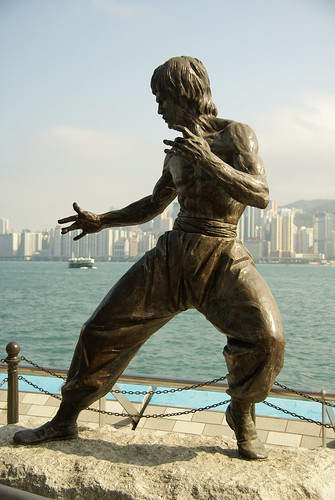
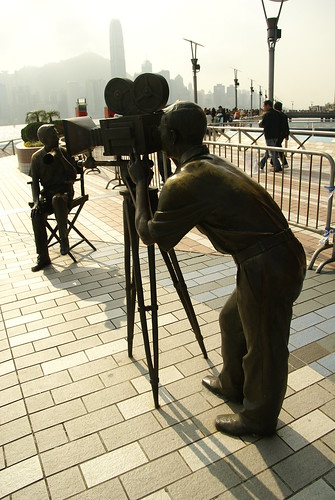
檢視較大的地圖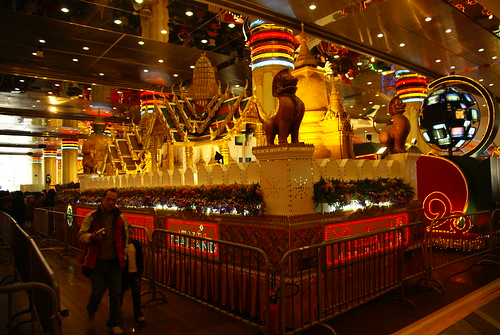

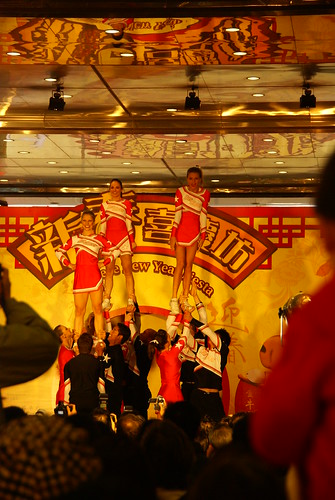
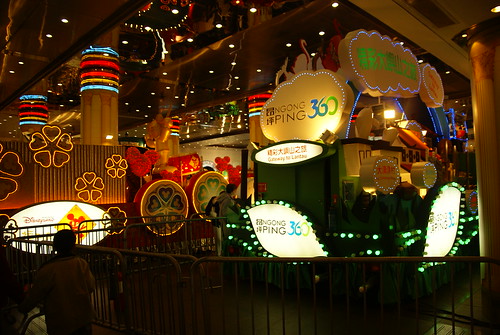
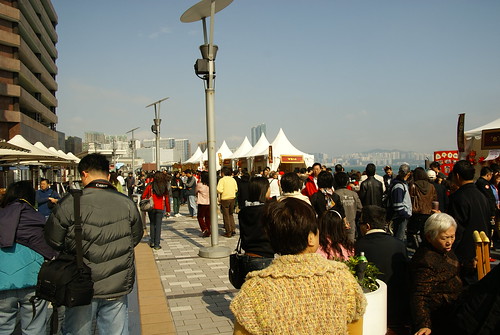
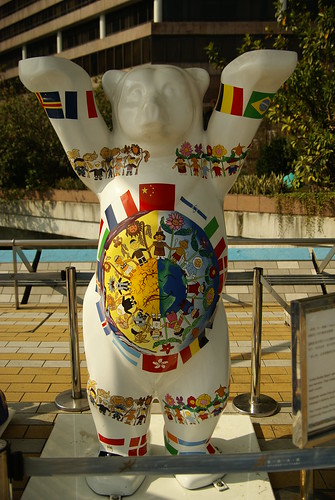
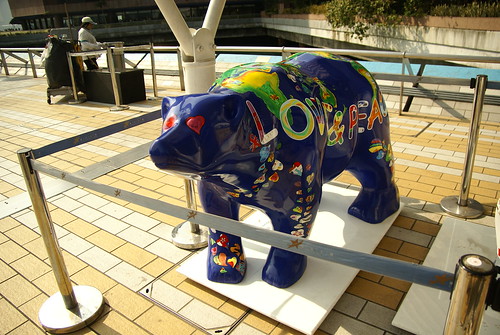
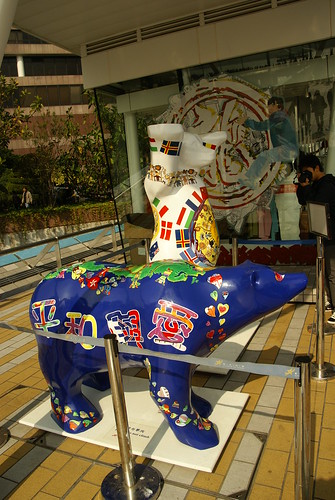
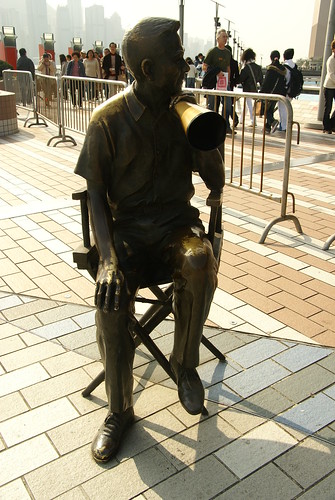
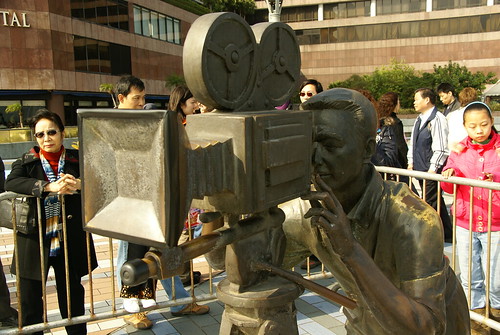
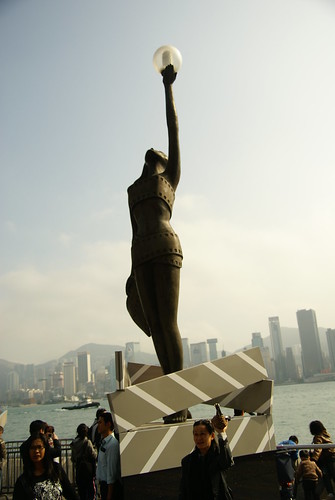
香港電影是華語電影的先驅者,華語電影是分割成四個地方發展的:香港電影、大陸電影、新加坡電影和台灣電影。香港作為英國的殖民地,在政治及經濟上也比中國大陸及台灣有更大自由,發展成為華語世界(包括海外華人社會)以至東亞電影的製作基地。幾十年來,香港一直是第三大電影工業基地(僅次於好萊塢和寶萊塢)和第二大電影出口地。就算1990年代中期開始的電影工業危機,加上中華人民共和國政府於1997年7月1日收回香港主權,香港電影仍然保持著自身獨有的特色同魅力,繼續在世界電影舞台上佔有重要地位。
與很多其他電影工業不同,香港電影幾乎沒有政府資助,香港政府更沒有對外來電影實施任何進口限額。因此,香港電影一向都較著重滿足觀衆口味的商業片,像無里頭式喜劇同動作片所主導。同時香港電影也經常「翻炒」:將過往成功的商業電影重拍,或者不斷開拍續集。
香港電影工業雖然面對好萊塢日益壯大的全球影響力,仍然能夠茁壯成長。事實上,香港在所在的地區,擁有媲美好萊塢的支配地位. 這地區的觀眾一向是香港電影的重要市場,不過現在香港電影比之前更受歡迎。不論泰國、新加坡、馬來西亞、印尼、韓國和台灣,外國市場和香港本土市場同樣重要. 在90年代初,台灣電影業十分蓬勃,可是在入口的香港電影猛攻之下,差不多消失。日本電影業己高度發展而且實力雄厚,日本觀眾又酷愛美國電影;然而香港電影在日本市場也能佔據次要的立足點.成龍在日本尤其受到歡迎.
在西方國家,香港燦爛的流行電影有一班支持者,而現在香港電影亦成為文化主流,滲透在世界每個角落並經常被模仿。香港電影的影響力在近年的好萊塢動作電影都可以見到。
星光大道為表揚香港電影界的傑出人士的特色景點,仿傚好萊塢星光大道,傑出電影工作者的芳名與手掌印鑲嵌在特製的紀念牌匾,以年代依次排列在星光大道上,目前星光大道可容納100名電影工作者的紀念牌匾。
星光大道放置多尊造型塑像,包括位於入口處的香港電影金像獎銅像、位於大道中段以電影拍攝情況為題材的系列塑像(包括導演、攝影師、燈光師及收音師)。2005年11月27日,一尊高兩公尺,按照電影《龍爭虎鬥》造型的李小龍銅像在香港星光大道揭幕,以紀念李小龍65歲冥壽。
星光大道設有三個紀念品銷售站與四個流動銷售站,提供各式小食及特色紀念品售賣服務。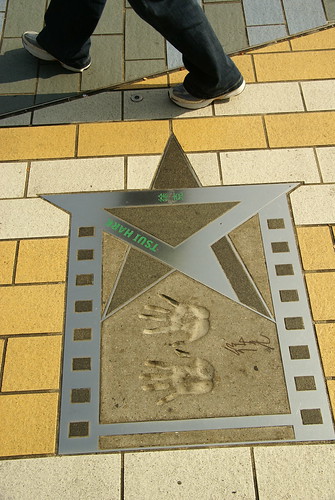
首批73名獲表揚的電影工作者,由香港電影金像獎協會及其九個屬會,聯同《電影雙周刊》以投票方式選出,並得到星光大道管理委員會的認可。有關提名及投票有三項準則:
1. 在香港電影業具頂尖地位;
2. 曾為香港電影業作出重大貢獻;
3. 業內備受推崇及資深的人士。
該會將每年選出新增獲嘉許名單。
* 首批獲嘉許的電影工作者
1. 黎民偉
2. 林楚楚
3. 胡蝶
4. 邵逸夫
5. 黃曼梨
6. 朱石麟
7. 曹達華
8. 盧敦
9. 岳楓
10. 關德興
11. 張活游
12. 吳楚帆
13. 新馬師曾
14. 白燕
15. 周璇
16. 張瑛
17. 李鐵
18. 胡鵬
19. 任劍輝
20. 石堅
21. 李麗華
22. 白光
23. 吳回
24. 白雪仙
25. 紅線女
26. 秦劍
27. 于素秋
28. 梁醒波
29. 鄧寄塵
30. 鄧碧雲
31. 芳艷芬
32. 夏夢
33. 林黛
34. 胡楓
35. 尤敏
36. 謝賢
37. 李翰祥
38. 陸運濤
39. 喬宏
40. 林鳳
41. 張徹
42. 楚原
43. 胡金銓
44. 凌波
45. 陳寶珠
46. 蕭芳芳
47. 馮寶寶
48. 王羽
49. 狄龍
50. 姜大衛
51. 何冠昌
52. 鄒文懷
53. 李小龍
54. 吳思遠
55. 許冠文
56. 許冠傑
57. 林青霞
58. 洪金寶
59. 成龍
60. 吳宇森
61. 袁和平
62. 許鞍華
63. 徐克
64. 周潤發
65. 張國榮
66. 劉德華
67. 李連杰
68. 張曼玉
69. 梅艷芳
70. 梁朝偉
71. 楊紫瓊
72. 王家衛
73. 周星馳
* 2005年11月宣佈新增的電影工作者名單:
1. 紫羅蓮
2. 王天林
3. 林家聲
4. 鮑方
5. 劉家良
6. 石慧
7. 傅奇
8. 葛蘭
9. 嘉玲
10. 關山
* 2006年11月宣佈新增的電影工作者名單:
1. 倪匡
2. 羅維
3. 唐佳
4. 黃霑
5. 麥嘉
6. 曾志偉
7. 張叔平
8. 梁家輝
9. 黃秋生
10. 張栢芝
* 2007年6月宣佈新增的電影工作者名單:
1. 張學友
2. 張艾嘉
3. 鞏俐
4. 劉青雲
5. 曾江
6. 郭富城
7. 黎明
8. 黎北海
香港星光大道(Avenue of Stars)的整本相簿:
相關網站:
香港星光大道- 維基百科,自由的百科全書
2009年4月13日 星期一
【香江新春】年初二煙火
吃完了晚餐,就從油麻地搭地鐵到尖沙咀看煙火。尖沙咀那裡的人真的是多到爆,海岸邊都擠滿的人,根本就過不去了,只能擠到一條大馬路上,煙火表演開始時,放煙火的方向還被兩個大路牌給擋著,只能從路牌後欣賞煙火。
香港大年初二,晚間在維多利亞港,舉行賀歲煙火匯演,歷時23分鐘,估計大約有50萬人在港邊看煙火,很多人白天就搶先在附近搶好位子。
牛年賀歲煙火前半場以恭喜發財為主題,又是8,又是牛字,還有吉字,除了字樣煙火,還有大量金元寶從天而降。
接著這一幕預祝香港舉辦東亞運動會,最後一幕六和十的紅色煙火字樣,則是慶祝中華人民共和國建政60周年,倒數一分鐘高速密集放煙火。
歷時23分鐘,10幕的煙火秀,因為不景氣,花的經費2千1百多萬元,比去年少了8百多萬。
煙火表演最初一段(04:47):
煙火表演高潮部分(01:33):
煙火表演的長版(12:59):
2009年4月11日 星期六
華人乎?
偶然看到這一篇文章:〈很有意思:老外總結華人的六十個特徵〉,來自我比較一下吧。
1. 熟人見面打招呼時不問好, 而是問「吃飽了嗎?」
這倒是不會,我通常會說「好久不賤!」
2. 喜歡吃雞腳。
一點也不愛:(
3. 吃魚時會吸魚頭和魚鰭。
完全不會。
4. 車子後視鏡上會吊中國擺設。
掛的是東南亞的,算嗎?
5. 喜歡唱卡拉OK。
還好,上次去KTV還被偷錄,據說很多人看過......
6. 房子舖的是瓷磚。
我比較喜歡地毯。
7. 廚房覆蓋著一層厚厚的油脂。
被發現了(>.<)
8. 爐子上面有鋁箔。
又被發現了(>"."<)
9. 遙控器外面包著塑料。
連搖控器都沒。
10. 從沒吻過你父母。
印象中的確好像沒有。
11. 從沒抱過你父母。
小時候的不算嗎?
12. 小學五年級開始就戴眼鏡了。
被發現了……可是是因為我以為戴眼鏡比較帥。
13. 睡醒後頭髮會豎起來。
真的耶……有一天一大早去台北東區搭捷運,一進車廂,所有OL和正妹都盯著我……好害羞哦……車門關上,從玻璃窗上的映象才被現,原來我是超級塞亞人,因為忘了梳頭髮:p
14. 會為一些不可置疑的事情辯論。
「不可置疑」?例如?神的存在?還是演化論是否為真?
15. 喜歡用折價券。
還蠻愛的:p
16. 為了最便宜的汽油費不惜開著車子到處找。
不必吧?上網找不就行了?
17. 每天總是到了晚上才洗澡。
有問題嗎?洗了香香,睡起覺來看會香甜。
18. 旅店房間裡的非免費食品都絕不吃。
有人付帳的話,要我吃多少都行。
19. 如果是男人,那麼身上的體毛比大多數女人少。
難道老外是反過來嗎?
20. 別人為他倒茶時,他表示感謝的方式是用手指敲一下桌子。
最近才學會的,不過有酒,幹嘛喝茶?
21. 表示感嘆時經常說「哎(第二聲)呀(第四聲)」和「哇(第四聲)」。
倒不是,我大部分是「幹」、「靠」、「HOLY SHIT!」、「GODDAMN!」或「「WHAT THE HELL?」。
22. 開車或坐在副駕駛座乘車時不喜歡繫安全帶, 因為繫安全帶讓他感覺不舒服和麻煩。
我很乖的,因為這裡的條伯伯美國時間很多。
23. 喜歡拉斯維加斯、老虎機和二十一點。
還好,我只是喜歡打賭,可是逢賭必輸:p
24. 廚房桌子上總是有一條濕呼呼的抹布。
太久忘記用就會乾掉……
25. 就餐時習慣把骨頭和其他咬碎吐在桌子上。
吃中國菜時,有人降做,才會有樣學樣…..
26. 電冰箱時常會存著很久以前放進去的食物。
被發現了XD
27. 廚房裡有洗碗機,但從來沒用過它。
偶爾會用。
28. 把洗碗機當碗櫥。
又被發現了:p
29. 特別喜歡用熱水瓶,而且每個熱水瓶裡面永遠裝滿熱水。
還是被發現了XD
30. 雖然有餐廳,但卻總是喜歡在廚房用餐。
餐廳和廚房的差別是?
31. 會在餐桌上當著眾人剔牙, 並且用手遮著嘴。
這倒是不會。
32. 坐在書桌旁時,經常會下意識地轉動手中的鉛筆或圓珠筆。
應該不會,因為辦不到XD
33. 冰箱裡時常存有三口剩飯、一隻雞翅或數塊乳腐。
被發現了XD
34. 喜歡把果醬瓶、雀巢咖啡瓶當水杯用。
違法嗎?
35. 有收集旅館免費洗髮水瓶子和牙刷、小木梳的嗜好。
不拿白不拿,又不違法。
36. 即使外出十五分鐘也會帶上零食:話梅、橄欖、乾芒果或烤魷魚等。
這倒不會。
37. 做飯前,總是要將米淘洗2-3遍以上,理由是必須將黴菌去除乾淨。
如果記得洗的話:p
38. 烹調菜餚羹湯和調制飲料酒水時從來不用量杯。
做甜點時才會用量杯,因為我老闆老婆說,做甜點不需要創意,要乖乖照食譜的量加,要不然會做出永不凝結的堤拉米蘇XD
39. 只用筷子打雞蛋, 從來不用打蛋器。
如果要打很多蛋蛋的話,就會用打蛋器。
40. 在家喝茶總是用一個帶蓋的茶杯。
不會,因為蓋子早打破了……
41. 總是在電話簿裡找電話號碼,因為諮詢電話要支付五角費用。
原來可以打諮詢電話哦?
42. 喜歡古裝武打片和其他中國功夫片。
還蠻喜歡的。
43. 平時和節慶假日期間從不為了問聲好而給父母發短信。
嗯,不過被人冒犯時,可能會問候別人的父母。
44. 如果他因事離家外出或平時同父母分居,他的父母會打電話問你吃了嗎, 就算半夜12點也不例外。
這倒還好,只有一次媽媽搞不清楚這裡的時間,凌晨三點打來XD
45. 當他病了的時候,他的父母會叮囑不要吃油炸和烤製的食品, 因為會上火!
是的,而且履試不爽,試了就不爽。
46. 經常利用工作時間和工作單位的電腦炒股、瀏覽與工作無關的網頁和無聊的信息, 或者給親友發送電子郵件和網聊。
最好老外就比較乖。
47. 吃自助餐之前先把自己餓個半死。
被發現了。
48. 想方設法打聽哪裡可以買到打折的家用電器、珠寶或服飾、化妝品。
又被發現了。
49. 把用過的可樂瓶收藏起來以備他用。
嗯,不過多數是回收掉。
50. 收藏鐵釘、螺帽、廢舊電線等五金電器零件,以備修理家用器具之需。
這倒不會。
51. 每管牙膏無論貴賤, 一定要擠淨用完,非擠到紙一樣薄不可。
盡量吧。
52. 中秋節一定要吃含有高油脂、高糖份的月餅。
有問題嗎?老外還不是每天吃高油脂、高糖份的速食。
53. 當廁紙臨時降價時,會搶購買100多卷囤在櫥櫃裡。
100多卷?如果我家夠大,我是會考慮。
54. 即使已經吃飽了, 但是當別人要把剩下的菜倒掉時,還會努力把它吃掉。
被發現了。
55. 夏天喜歡吃紅豆冰棒或綠豆冰棒,捨不得吃刨冰。
我比較喜歡吃刨冰。
56. 愛好吃苦瓜。
還OK。
57. 拜訪別人時會帶著水果。
我會帶酒:)
58. 餐後爭著搶著付帳單。
爭著把帳單推給別人倒是真的。
59. 選學的專業往往是實用型的,如計算機、機械、財會或法律。
不會,我學的一點也不實用。
60. 即使到了三十歲還和父母住在一起,或者已經結婚成家了,還住在父母隔壁或同一個鄰區,而父母也喜歡他這樣。
我應該不會,我老弟倒是住在爸媽附近。
好吧,我好像有超過一半是符合的:p
2009年4月10日 星期五
狗屎!放屁!

來談一本很變態的小書──On Bullshit。
On Bullshit這本書在兩三年前,在《紐約時報》和Amazon.com的暢銷書排行榜上佔據了相當久的時間,印象沒錯的話似乎至少有一兩年哦。可是,那還引不起我的興趣,因為很多爛書,只是搞了噱頭,就讓人以為值得一讀。
後來有朋友提到這本書,然後很不巧的,它的中譯版也出版了,是台灣文化界的大佬南方朔翻譯的。以下是中文版的文宣:
基本上,在美國,我們常把bullshit這個不雅的字簡稱為BS,以下我就用BS來表示bullshit或放屁吧。那個文宣,隨便看看就好,它看來也還蠻BS的,因為我也搞不清楚「放屁」和「鬼扯」的差別,才疏學淺的小弟以為BS就是「放屁」或「鬼扯」耶。
《放屁》這本小書,變態之處,除了其書名外,還有一點,就是它基本上只有口裝書的大小,其原文版,只有區區的80頁!在Amazon.com上,居然還要$9.95,比一些大部頭的書都還要貴咧。據說很多人拿到書時,就有上當的感覺,感覺那本書本身就是BS,因為《放屁》其實不算是本書,而是篇文章!
可是On Bullshit這在《紐約時報》和Amazon.com的暢銷書排行榜上佔據了那麼長久,那上當的人也太「罄竹難書」了吧?
其實我原本以為《放屁》這種變態的暢銷書,應該是個小作家,捉對了大眾的胃口,寫來符合大眾口味騙錢用的吧。可是一點也不然,《放屁》可是美國一流名校普林斯頓大學的道德哲學教授Harry G. Frankfurt所著的。
《放屁》要試圖探討,為何我們的文化中,有這麼多的BS。美國的社會上,真的充滿BS。美國的大學生在大學中最重要要學的,很可悲的,甚至不是知識,而是如何漂亮地BS。只要有改過美國學生的作業或考卷,就能見識到,他們如何能夠在完全不瞭解題目和答案的情況下,把腦中所有專有名詞組織成一篇看似有道理可是內容極度空泛的答案和文章之能力。
而且,不要說大眾文化中有太多的BS,連嚴肅的科學界都不落人後。我在寫論文時,老闆就直接說,如果我循規蹈矩地寫引言、材料與方法及結果,討論的部分要多少BS都隨便,審稿者也不會太在乎的。
更甭提,只要是一個稍微有常識的普通人,有多清楚在大眾文化中,媒體和政客每天製造了多少噸的BS(媒體和政客原來都不是人啊?要不然怎麼搞出BULLshit)。甚至連我們在不在乎BS,也和我們腦中裝的BS有關──只要和腦中BS不臭味相投的,才算是BS。
《放屁》第一部份考究Bullshit一字的起源,追朔至另一英文字Humbug(鬼扯)。Harry G. Frankfurt花了很多篇幅去論述Bullshit和Humbug的微妙差異﹐亦同時指出BS與謊言是兩個完全不同的慨念。其後Harry G. Frankfurt引用語言分析哲學大師維根斯坦 (Ludwig Wittgenstein, 1889-1051)的方法,去介定BS的定義。他詳細比較BS、謊言(Lie)和大話(Buff)的分別,指出三者雖然看似相似,但本質上完全不同。三者在講者腦中由不同的慨念構成,而聽者腦中亦要用不同慨念去衡量。
而《放屁》一書的最終目的,是要指出,大家所廣為接受的BS,比起大家所痛恨的謊言,還不道德!
怎麼說呢?當一個人說謊時,他知道什麼是是非黑白對錯,只是他故意說反。可是當一個人在BS時,他或許知道也許不知道什麼是是非黑白對錯,不過他不在乎什麼是是非黑白對錯,甚至不想知道什麼是是非黑白對錯,不管是非黑白對錯是什麼,只要能達成他的目的,是非黑白對錯是什麼,一點也不重要。所以當一個人在BS時,可以十句話摻兩三句或其至七八句假話,而哪些是真哪些是假,並不重要,甚至也搞不清楚,反正BS的目的,就只是為了能達成自私的目的。
因此,盡管BS和謊言相比,BS比較廣為大眾接受(或習慣),BS在道德上,是比謊言更不堪的!也是「真理」更大的敵人!也因為太少人意識到BS的可惡,所以社會上就只能有愈來愈多的BS,多每天充斥假新聞也無所謂,多到什麼是真實的,也不再需要明辨,而是非黑白對錯越來越不重要……
在這個真理愈來愈不明的時代裡,《放屁》的確才是一本很值得一讀,非常有創見的書。把短小精悍的《放屁》看完,根本不需要花一個小時以上。可是看完後,才知道我們的腦子裡,有意無意裝入和產生了多少BS。或許,這本書的原文版應該要列為大學生英文必讀讀物,其中文版應該列為高中生必讀課外讀物吧!
閱讀全文...
張貼者:
Gene Ng
於
上午11:10:00
2
意見
![]()
標籤: 閱讀
2009年4月7日 星期二
【香江新春】油麻地天后廟(Tin Hau Temple)
油麻地天后廟(Tin Hau Temple)是香港九龍規模最大的天后廟,位於油麻地廟街近眾坊街一帶,現由東華三院委託華人廟宇委員會管理,為香港二級歷史建築。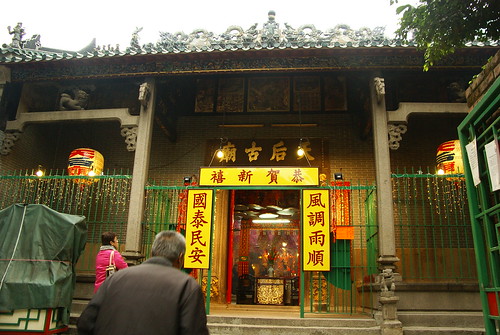
檢視較大的地圖
油麻地天后廟於1865年由當地的水上居民所建,原為油麻地海邊的一座小廟宇,當時位置約於今日的北海街一帶。1870年,油麻地居民組成油麻地五約,重修該天后廟,成為當地的宗教中心及最繁盛的地方。當時天后廟前的土地是漁民曬船上麻纜的地方,而不少經營補漁船的桐油及麻纜商店在那裡開設,成為「油蔴地」這個地名的起源。
惟1874年甲戌風災,原廟被摧毀。當地居民遂於翌年籌募經費重建,1876年選取現址開始動工,1890年始告全面落成。而於1887年,天后廟以南及以北的街道被政府命名為「廟南街」和「廟北街」,其後合併為廟街,也是「廟街」這個街名的起源。
1916年,油麻地天后廟再被修葺,同時其部份事務開始被廣華醫院接手管理,以補貼醫院經費。1928年,華人廟宇委員會正式將油麻地天后廟移交廣華醫院。1931年,東華醫院、廣華醫院及東華東院正式統一為東華三院,並連同鄰近的油麻地福德祠由東華三院接管。油麻地天后廟於1969年至1972年重修,並與鄰近的油麻地城隍廟、油麻地社壇及油麻地書院合併運作及管理。
油麻地天后廟以天后廟正殿為中,兩側則建有油麻地觀音樓、油麻地城隍廟、油麻地觀音樓社壇及油麻地書院,各座建築主祀不同的神靈。
廟中保留的歷史文物極為豐富,其中有1860年的石獅子,1865年、1875年、1890年及1916年所立的廟碑,1888年、1897年鑄的銅鐘,以及頗多的木石雕刻。而廟頂的1916年石灣瓦脊,至今依然存在。
到了天后廟,已經快五點了,可惜廟街都還沒開始營業,要不然在拍完照後,倒是可以去逛一逛。
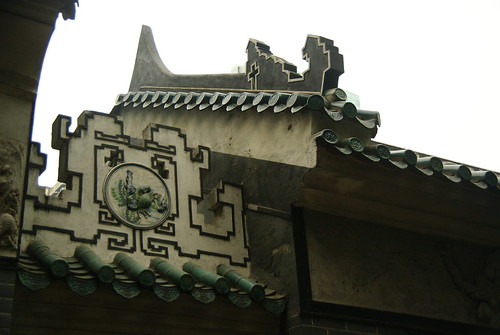
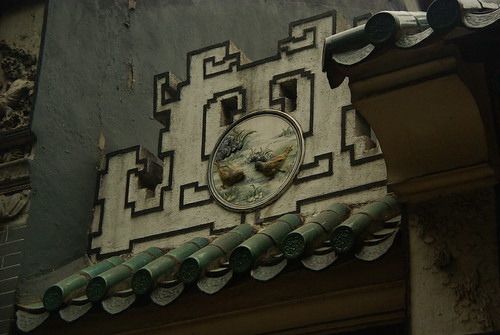


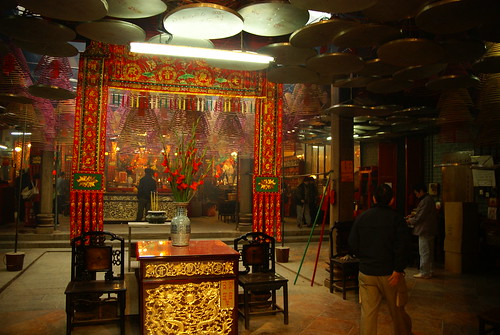
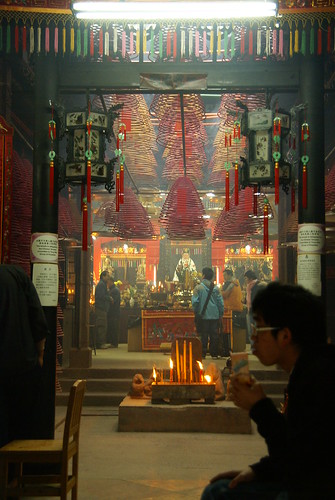
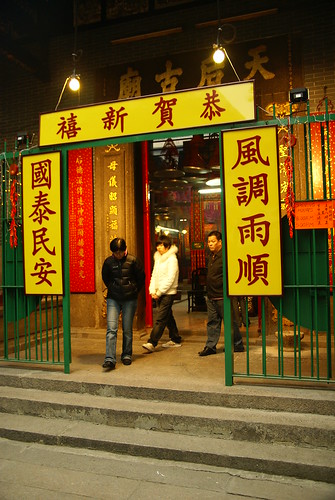
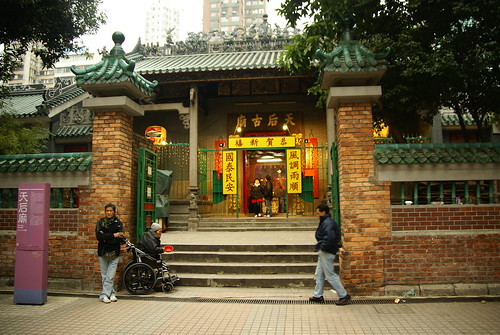
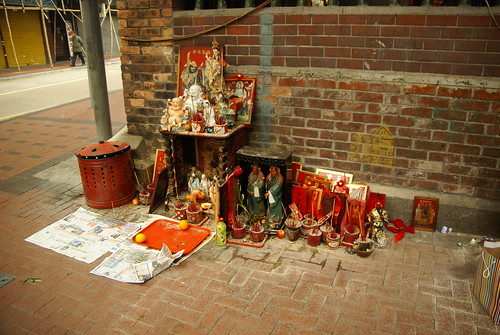
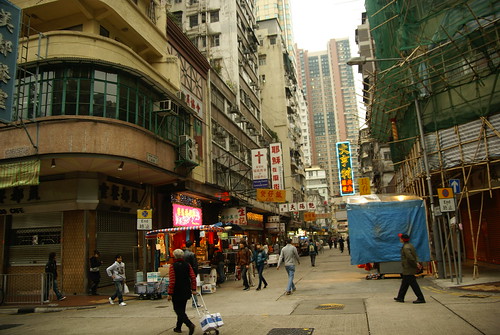
廟街(Temple Street)位於香港九龍油尖旺區中的油麻地,是香港一條富有特色的街道。街道南北走向,連接文明里及佐敦道。曾有不少電影以廟街取景。廟街以售賣平價貨的夜市而聞名,被喻為香港的平民夜總會。
清朝時期,廟街的中段建有一座天后廟,即油麻地天后廟,廟街因而得名。另一方面,由於廟街的性質與旺角的女人街相似,而到訪的人則以男性為主,故亦有男人街的稱號。香港年輕一輩,多以「老廟」作為廟街的俗稱。
廟街早於1887年的九龍地圖上已有紀錄。當時廟街分為兩段,以油麻地天后廟為界,以北一段被稱為「廟北街」,以南一段則稱為「廟南街」。由1920年代開始,天后廟對出的廣場(俗稱「榕樹頭」),開始發展成大笪地式的休憩場地,帶動了廟街附近不少販賣雜物及小食攤檔的存在。廣場對出一帶的街道眾坊街(英文為 PUBLIC SQUARE 以前曾譯為「公眾四方街」),也是由這個廣場得名的。
1968年,香港政府擬在天后廟的廣場的附近興建梁顯利社區服務中心,引起該處經營的200多個流動小販對搬遷安排的不滿。在油麻地街坊會及香港警方協調後,政府決定在廟街及上海街近榕樹頭一帶劃出面積3呎乖4呎的攤位作安置之用,但須經過抽籤分配。
1975年3月,當時的香港市政局在廟街劃出「小販認可區」,使廟街原有的小販得到有系統的管理。廟街的小販認可區包括文明里至眾坊街一段,以及甘肅街至南京街一段,共有近600多個劃定位置供小販擺賣。攤位本來在傍晚開始營業,1998年中部份的營業時間更改由中午開始。
每天從傍晚時份開始,廟街路邊的攤檔便會陸續開始營業。攤檔售賣的物品相當多元化,包括男性服裝、手工藝品、茶具、玉器、古董、廉價電子產品,以至是成人用品都有。而在天后廟外有不少看相算命的攤檔,有時候附近還會有傳統粵劇表演。早年更曾有一些武師在此表演賣藝及賣藥。
除此之外,廟街內也有不少富有香港本土特色小食的攤檔,包括海鮮、煲仔飯及各類麵食等等。由於價錢大眾化,而且口碑不俗,深受居民以及外地遊客歡迎。
廟街亦開設有一些麻雀館,部份已有數十年歷史,甚有傳統文化特色,光顧多屬老一輩人士。
油麻地天后廟(Tin Hau Temple)的整本相簿:
相關網站:
油麻地天后廟- 維基百科,自由的百科全書
2009年4月6日 星期一
【香江新春】曾大屋(Tsang Tai Uk)
曾大屋(又稱「曾氏大屋」,舊稱「山下圍」或「山廈圍」,Tsang Tai Uk)位於香港新界沙田區博康邨南端旁邊,鄰近獅子山隧道,是區內保存得最好的圍村之一,亦是僅存的最大客家式大宅。圍村在第二次世界大戰時曾收容逃難人士,所以被尊稱為「曾大屋」。
檢視較大的地圖
曾大屋是曾氏家族的住宅,由曾貫萬(又名曾三利)於1848年建造,歷時二十年,至1867年才建成。曾氏建宅的起源有二:
一、曾氏在西灣河經營石礦場,並在筲箕灣開設三利石廠,後來致富,便在沙田興建圍村供族人居住。
二、曾貫萬是五品官,相傳有一班海盜劫漁船得鹹魚16甕,登門求售,曾以每甕800錢買下,後來他發覺鹹魚下面全是金銀,而海盜又一去不回,遂用之興建建宅。
曾大屋呈長方形,總面積達6000多平方公尺,採用了曾氏的五華老家的建築風格──堡壘式的格局,圍牆採用了花崗石、青磚和精選的木材,而四角均築有鑊耳型的三層高碉堡,碉堡上有槍孔和瞭望台,用以對付盜賊的侵襲。本來曾大屋外面有一條護城河圍繞整座堡壘,以吊橋啣接,但現已遭填塞,吊橋亦拆去。
檢視較大的地圖
村內的建築主要分上、中、下三廳,廳與廳之間有天井分隔,這三個廳又稱為三楝上下進與左右兩橫屋相連,形成棋盤狀,圍屋內有住屋百多間。圍村入口有三個大門,中門最大,門頂圓拱形,四週以麻石砌成,門頂石匾鐫刻著「一貫世居」,門上有酸枝木和鐵枝製成的門閂,並有一道鐵門。正廳門前有「大夫第」木匾和「祥徵萬福」石匾。庭院內還有兩口井。
曾大屋的建築充滿官家氣派,將防禦和抗敵的因素集於一身,與新界的其他圍村迥然不同。
到曾大屋前,我以為曾大屋是香港法定古蹟,整個被完整保留下來讓遊客盡情參觀,到了曾大屋,才發現原來那還是私家財產,還有人住在曾大屋裡面,而曾大屋由於是一個集體住宅,有些人的家外面還貼有磁磚和換上新鐵門以及空調,和曾大屋的古色古香很不搭調。
由於發現裡頭還有住人,我個性內向害羞,加上不知如果參觀才不會太打攪他們,就隨便看看拍照。可能是春節的關係,有幾戶人家貼有春聯,還蠻有味道的。曾大屋有一個中廳,擺有他們的祖先遺照,供子孫瞻仰。

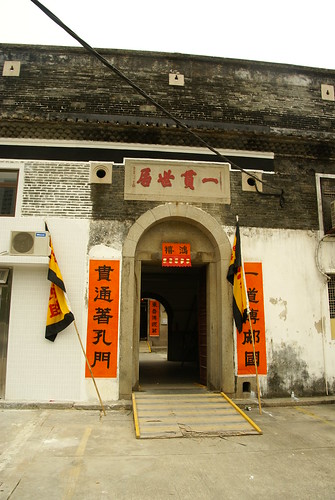
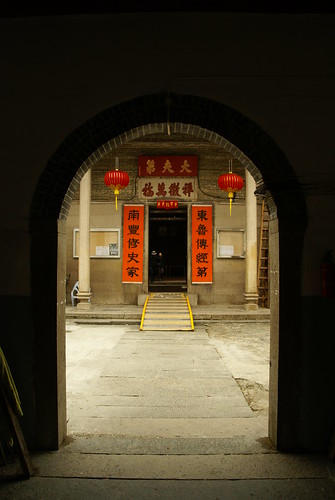
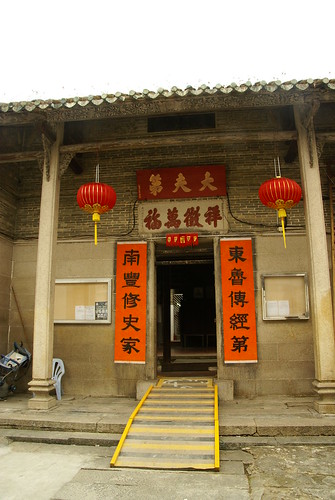
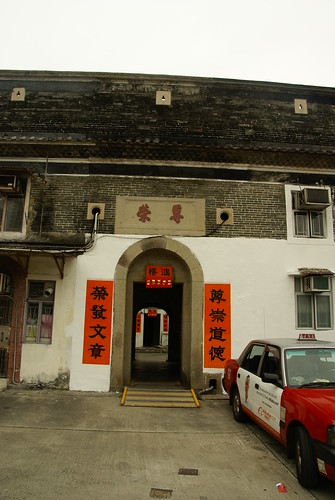
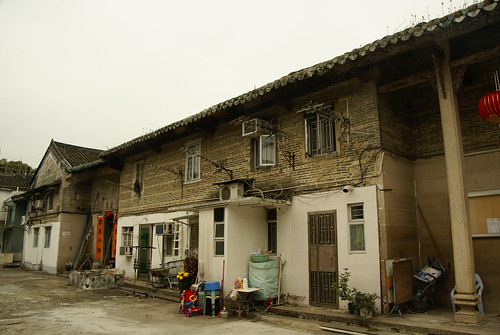

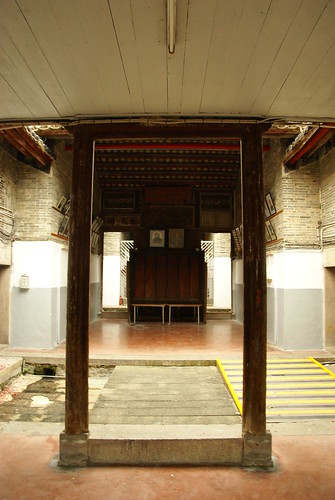
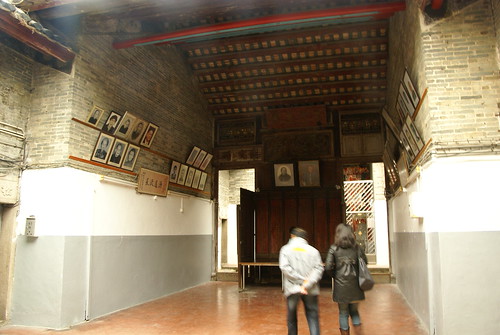
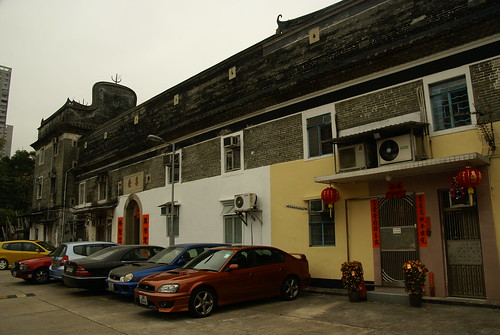
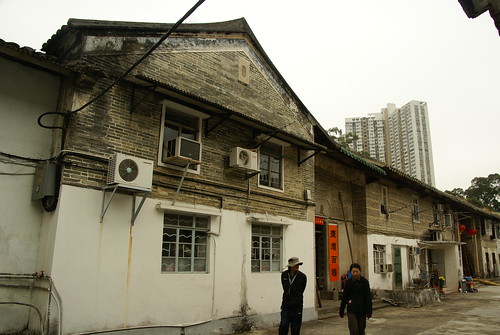
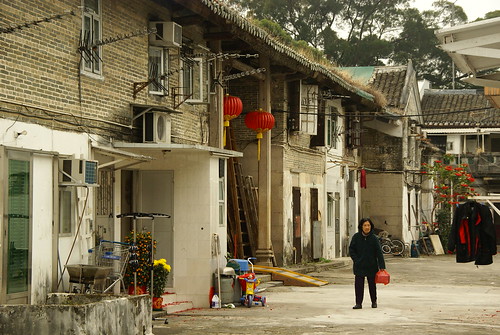

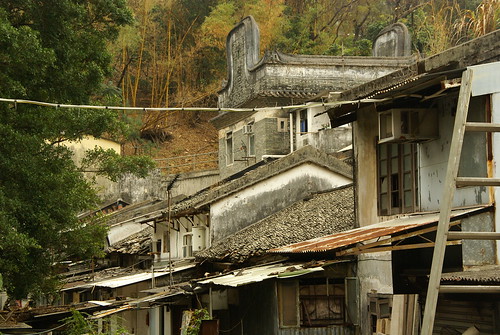
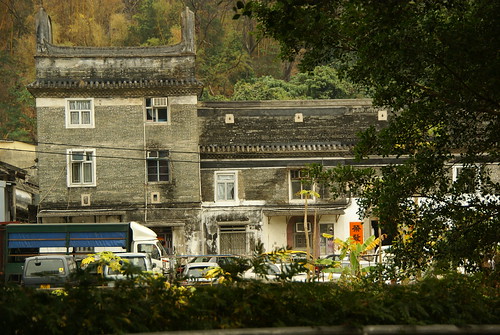
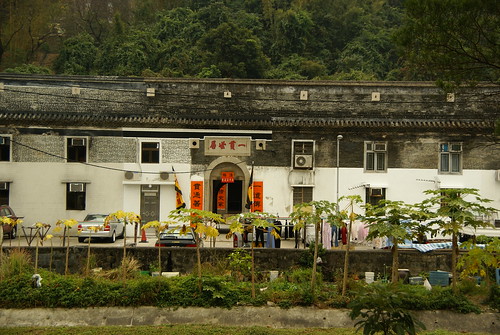
參觀完曾大屋,就回去搭地鐵去油麻地吃晚餐,準備晚上去看煙火。
曾大屋(Tsang Tai Uk)的整本相簿:
相關網站:
曾大屋-維基百科,自由的百科全書







